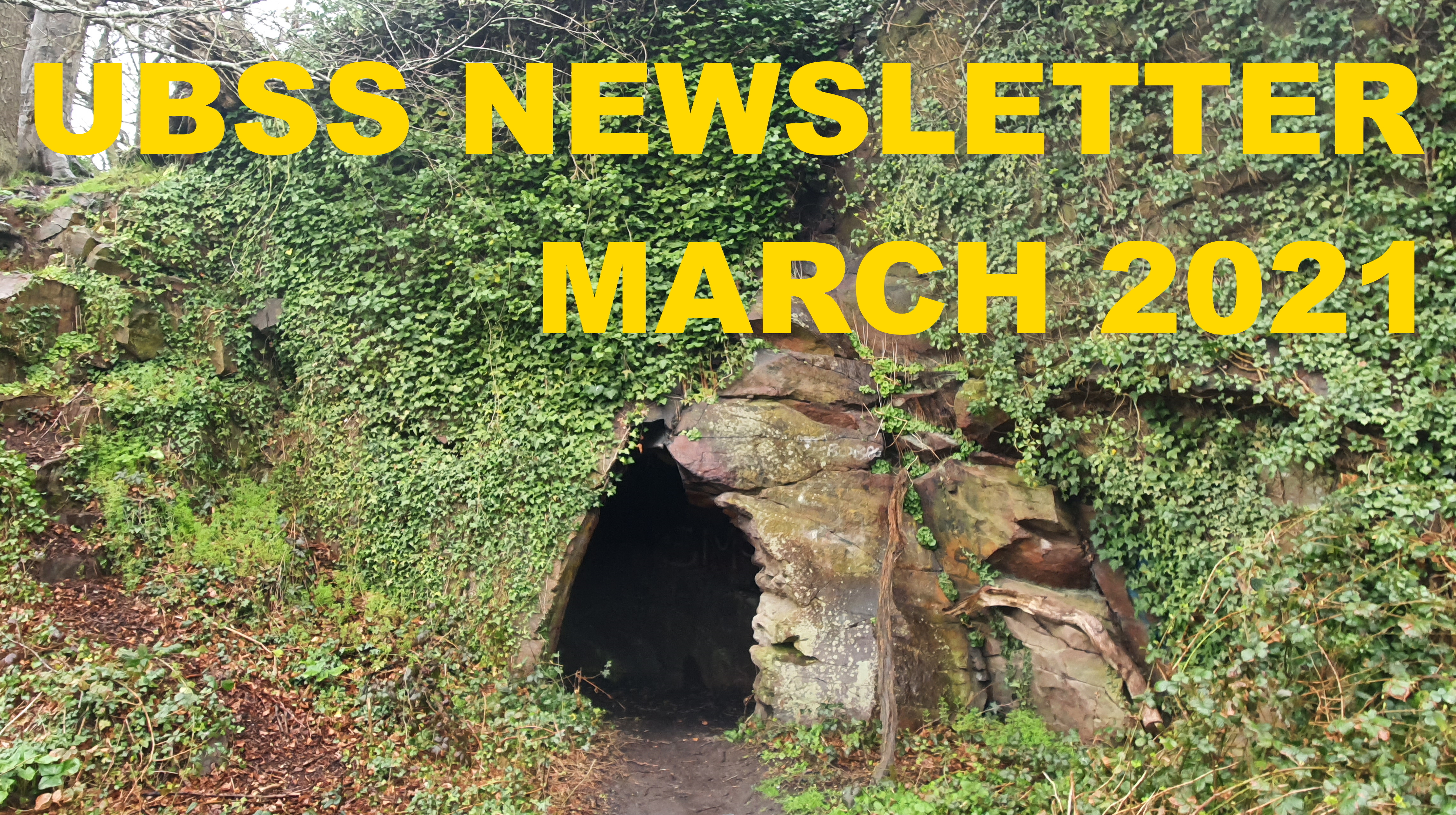
It's Guess the Cave time! A prize for anyone who can guess which cave this is.
Hint, it's within a 20 minute drive of Bristol, but not in the
Mendips.The answer will be given in the next issue, along with any
hilariously inept guesses.
|
|
Spring
is here and lockdown restrictions are starting to ease in various parts
of the country. We're looking forward to a return to local caving and so
more trip reports! We're pretty amazed that we've managed to keep the
newsletter going every month in Plague Times, so a big thank you to
everyone who has contributed articles, photos and other stuff. We even
have material in hand for the next issue, so many thanks to Lena
Ferriday, Steve Hobbs and Dickon Morris! Your contributions haven't been
overlooked, but your editors are about to collapse in a heap,
exhausted.
The number of people who Read to the End and email us with comments is
really great, and your emails delight our little editorial hearts, so
please keep them coming!
We get on average over 100 people opening the newsletter every month.
The number of 'reads' will be higher than that, as the stats don't pick
up anyone who reads on preview without fully opening. This is a
massively high proportion of the membership ad makes the effort of
putting this together every month all worthwhile.
As Mia will be studying abroad next academic year, please welcome Zac Woodford as a member of the editorial team! Anyone else who wants to get involved would also be most welcome.
The Tuesday evening quiz and pub nights have continued, and the
weekly practice showed, as you'll see later. Keep an eye on Facebook for
details but if you're not on there and would like to come along, let us know and we'll get the links for the Zoom calls sent over to you.
Everyone is going through difficult times and if any member - new or old
- is struggling with anything and wants a listening ear, remember that
UBSS is a supportive community that is always here to help. So drop us a line if you'd ever like to chat!
Back issues of the newsletter can be found here.
Linda and Mia
|
|
THE STUDENT PREZZ'S BIT
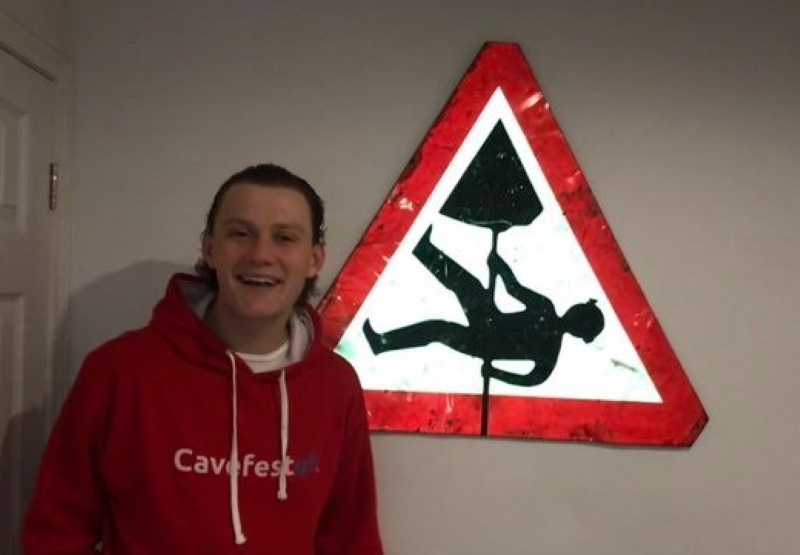
Student Prezz Henry Morgan posing in front of a sign demonstrating how to abseil off a perfectly sound belay.
As
we move with great excitement towards the easing of lockdown and a
resumption of underground activities, I have been asked as incoming
student president to write a few words for the newsletter.
First of all, I would like to extend my thanks to the committee of last
year for coping so admirably despite the disruption and lack of
opportunity to organise the events which we all look forward to so much.
The committee is largely similar this year, with the loss of Mia as a
newsletter editor (to be replaced by Zac) as she moves to her year
abroad. I hope that this means there will be opportunity to put in place
the plans that were made last year for an active year of caving ahead.
I have a great deal of hope for the year ahead, that within the next few
weeks and months we will be able to get back to exploring new caves,
teaching new members about caving and, of course, enjoying a beer or two
with friends we haven’t seen in a while. I am particularly looking
forward to the trip to the Gouffre Berger (and wider Vercours area) in
August/September (fingers crossed!) and a return of club weekends at the
hut in Burrington Coombe. I’m sure that the hard work that goes into
organising these events will make them worth the wait after such a
disappointing year for underground activity.
I hope that many of you share the excitement that I have for a return to
mixing with other cavers, and I hope to see plenty of you underground
in the near future.
Henry Morgan
|
|
A CAUTIOUS RETURN TO CAVING
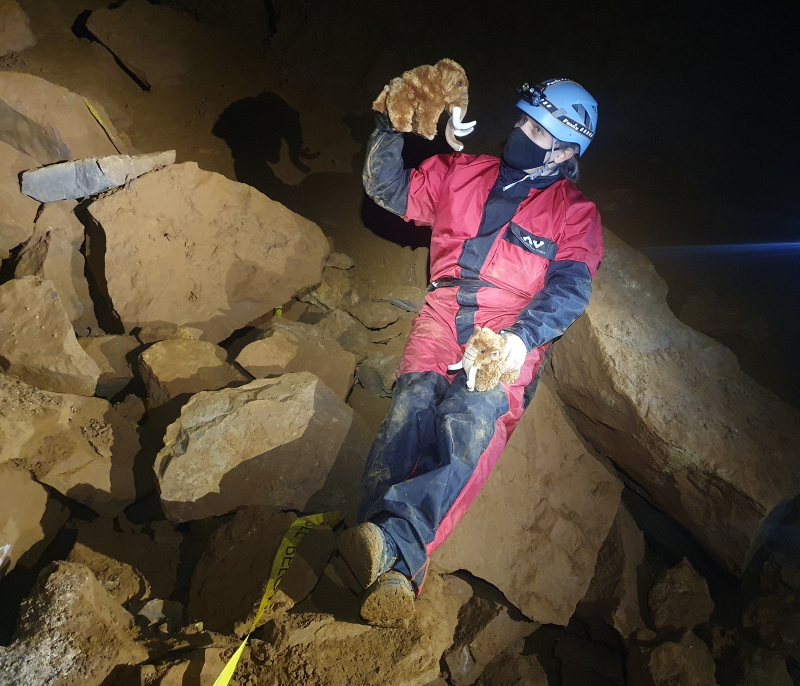
A cave that isn't in Bristol!! Nathan
Cubitt posing with Whatley Mammoth and his young cousin, St. Front, in
Shute Shelve Cavern, Mendip, with some of that pesky cryogenic stal
muscling in on the shot on the bottom left corner.
With the phased return to a more
'normal' life, we've done our best to collate some information for you
regarding what all the government guidance might mean for caving. As
ever, there are a lot of grey areas, but we how the following with be of
some help. Please note that the guidance referred to here only covers
England. As yet, we don't have a clear picture for Scotland and Wales.
If any members in those areas can supply details for the next
newsletter, that would be very helpful.
An email from the Chair of the Council of Southern Caving Clubs.
Dear Southern Cavers,
It is with some relief that as from Monday 29th March that the national
"stay at home" rule will end, and the long path to a return to something
like normality can begin. This means that it is no longer illegal to
leave home without a valid excuse, though the government asks that we
all minimise the number of journeys we make. From Monday 29th it is also
permitted for up to 6 people, or two households, to meet outdoors and
for people to take part formally organised outdoor sports.
The government's COVID-19 Response document can be found here.
Given the above advice, it is likely that many cavers will be
contemplating a welcome return to the underground. Whilst welcoming this
long awaited event, CSCC would like to remind cavers that things are
not yet back to normal and request that cavers carefully consider their
actions when returning to caving areas in the South.
Firstly, please ensure that your actions are in line with the latest
government advice, noting that the dates given may be subject to change
depending upon how the infection statistics are responding. Secondly
please plan your return trips carefully, remember you may be somewhat
rusty after a year or so off so best to start your return gently
(especially as rescue teams will still be hampered by having to adhere
to measures to reduce t he chance of infection). Thirdly please be
considerate to the local communities, the pandemic is not over yet. As
such some landowners may not be happy with visits until lockdown is
completely lifted (as was the case last summer). As such it is advisable
to check with the landowner prior to visiting and not just assume it is
OK. Please let CSCC know if you come across any such access issues
(either email one of the officers via the webpage or the CSCC Facebook page)
so that we can spread the news. Finally please try to avoid crowding
popular caves and parking places in your eagerness to get back
underground.
As yet overnight stays are not possible, and it is likely that most (if
not all) of the caving huts will remain closed (this is a decision for
individual member clubs).
CSCC will endevour to keep you up to speed with the situation as it evolves via the usual outlets.
All the best,
Ed Waters (CSCC Chair)
The British Caving Association has issued a Covid Roadmap Update.
You can read this in full here, and this also contains some useful links.
What does this mean for the use of the Hut?
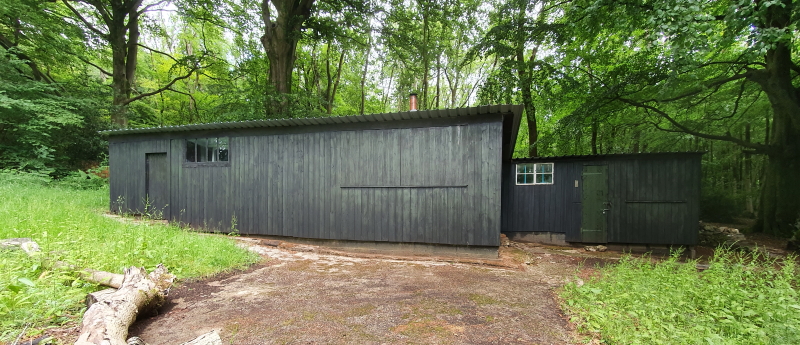
Key dates are as follows:
12th April (Step 2). From this date, use of self-contained accommodation
is allowed i.e. possibly club huts on a single household basis,
plus the “rule of 6” outdoors but with the caveat still, to minimise
travel. This seems to pave the way for the use of the Hut by a single
household at a time (and in this context, a 'bubble' does appear to come
within the definition of household).
17th May (Step 3). From this date, restrictions will allow up to two
groups of six or two households to meet indoors and stay overnight
potentially allowing more use of the Hut. Additionally, there appear to
be no travel restrictions and with up to 30 people able to meet
outdoors, this will hopefully allow a return to more “normal” caving
activities and use of the hut.
Please note that the hut is only available for use by members
accompanied by guests who fall within the above guidance. The hut is not
open for booking by outside groups.
For all bookings, please contact the club's Covid Officer, Imogen Clement, and if you have any queries, Imogen will do her best to help.
|
|
WARNING - MASSIVE ROCKFALL IN G.B. CAVERN
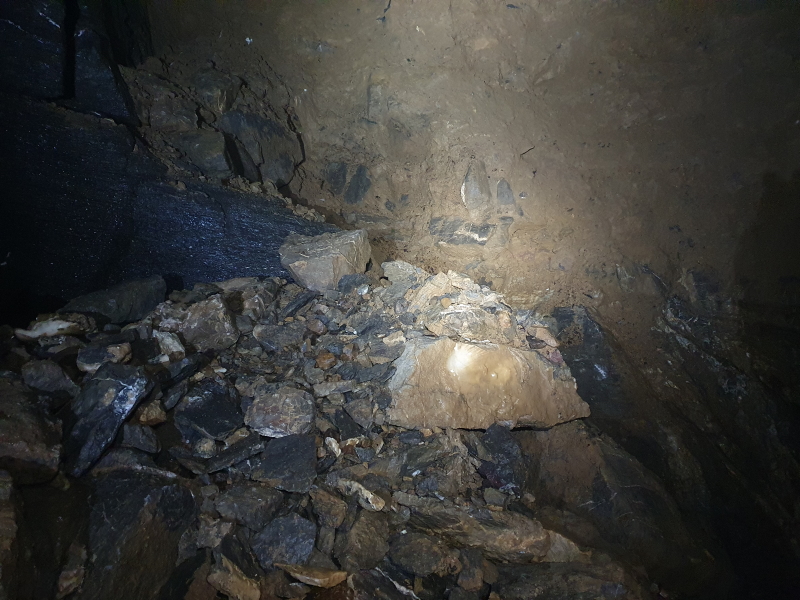
Boulder pile now covering the lower half of the Waterfall Climb in Main Chamber. Photo Linda Wilson.
The following warning has been
issued by Linda Wilson in her capacity as CCC Ltd Conservation Officer.
Please read and don't be tempted to cross the tapes to inspect this for
yourself!
In early February, the following report was circulated on a rockfall in GB by the Waterfall Climb in Main Chamber:
“There has been a recent fall of mud, gravel and smallish boulders on
the left (when viewed facing downstream) of the waterfall climb, near
the bottom of Main Chamber. The wall above the last part of the climb
(the big steps) appears as it did before, but should be considered loose
due to the recent fall. The top part is calcited but might be subject
to further falls, although it is equally possible that it might not
change for a long time. However, as assessing such future possibilities
is not an exact science, care should be taken here, and everyone should
conduct their own risk assessments whenever they approach this area from
any direction. There are still loose rocks almost covering the steps
and when inspected it was not possible to pass the steps without using
the unconsolidated debris. The floor below the climb is currently
covered with unconsolidated debris and the boulders here will move
underfoot when stepped on, so care should also be taken here.”
A further inspection trip was scheduled for 6 April, following the relaxation of covid restrictions. On 5th
April, a report was received of a further fall. The inspection trip
comprised myself, Dave King and Graham Price (plus two others). We found
that a large area of the side of the passage above the big steps on the
left hand side (when travelling into the cave, heading downstream) has
come away, resulting in a massive, unstable talus cone of boulders,
large rocks, smaller shattered rocks and mud that now completely covers
the steps almost to the base of the ledge in the middle of the climb.
Boulders and large rocks are spread over a wide area in the passage
below the climb.
There is still a ridge of loosely calcited unstable rock high up on the
wall above this area, so further falls cannot be ruled out. In addition,
there has been some mud slumping on the right hand side of the passage
when going downstream and this area might also be subject to some
movement.
A thorough inspection was carried out. As a result, warning tape has
been placed across the passage above and below the climb, stating: “WARNING, LOOSE BOULDERS, DO NOT USE WATERFALL CLIMB, USE WHITE PASSAGE/LOOP ROUTE INSTEAD, CCC Ltd 6.4.21”
These signs are laminated and attached to the tape with cable ties. A
sign was also placed at the Bridge and one has been hung from the bar in
the entrance. Please DO NOT cross these tapes to look at the fall.
As there is an alternative route to reach the lower part of the cave and
Bat Passage, it was not felt necessary to close the cave as the area
around the Waterfall climb can be bypassed in entirety, and the taping
below the climb was placed some distance outside the furthest extent of
the boulder fall. It will need several years of winter water conditions
to even start to stabilise this area, so this part of the cave will need
to remain off limits for the foreseeable future. The situation will be
monitored. An attempt was made at fixed point photography so we have a
baseline for the monitoring. As an aside, one of our original fixed
photography points at the base of the lower ‘big step’ for SSSI
monitoring is now completely covered by the talus cone. This is
certainly the most dramatic change to the cave in the time I have been
conducting the monitoring! Previously to this, the only change in the
photos was the door falling off one of the cars at the very top of the
Gorge.
A further news report with photographs will be put together and published.
Would all club reps please circulate this warning as widely as possible
in your clubs and ensure that key issuing procedures include this
warning. Also please ask all parties to report any broken tape or
missing warning signs so that we can replace them. For information there
is one sign in the blockhouse, one at the Bridge and three hanging from
each section of tape.
If anyone has any queries, please let me know.
Linda Wilson
CCC Ltd Conservation Officer
|
|
TRIP REPORT - GB
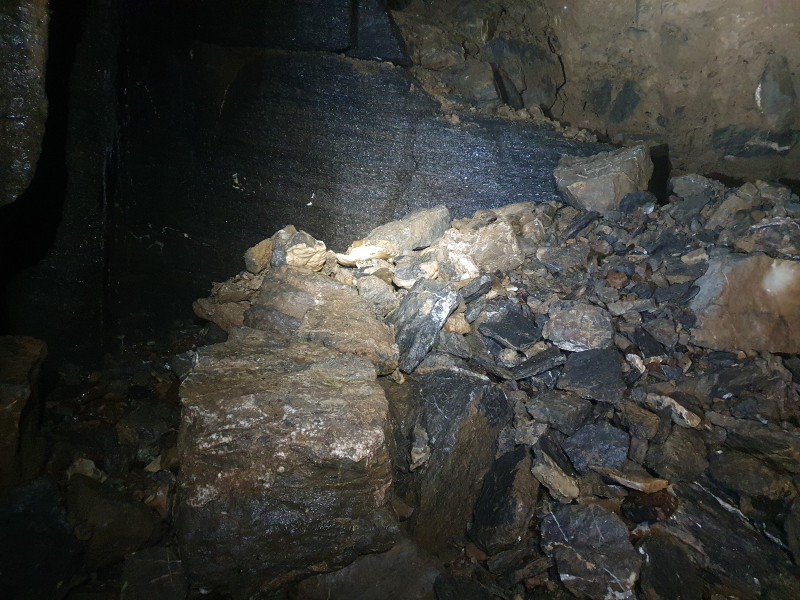
New boulder pile at the base of the Waterfall climb. Photo by Linda Wilson.
Linda reports on the inspection trip to check out the rockfalls in the vicinity of the Waterfall climb in GB.
On a bright, sunny Tuesday morning, myself, Clive Owen and Helen
Rossington headed out to Mendip to meet CCC Ltd directors Graham Price
and Dave King. This was our first opportunity following the easing of
lockdown restrictions to check out the situation at the Waterfall climb.
Based on a report received the previous day of a further fall, we'd
gone armed with warning tape and signs (nicely printed and laminated by
Richard Rossington during a garden lunch on Easter Monday). See, we can
do planning and preparation when we get our act together!
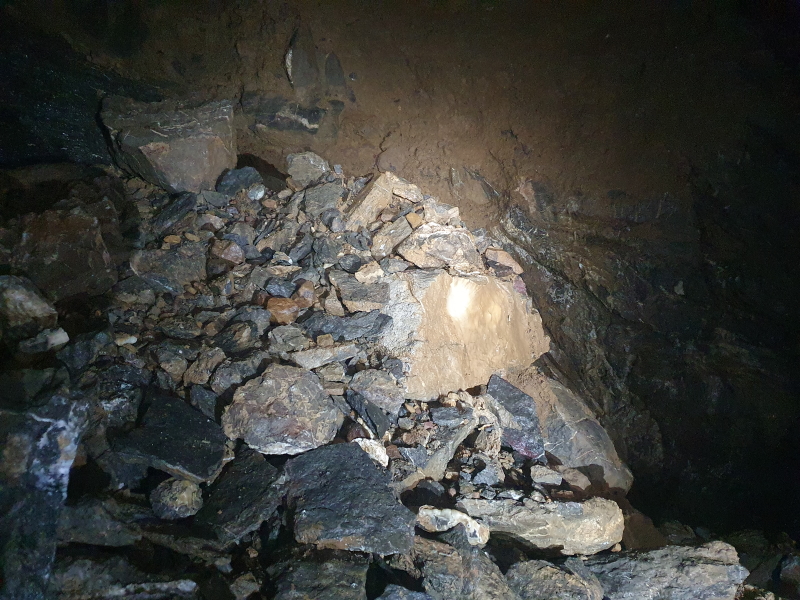
More boulders!
We arrived at the Waterfall climb and
stared in amazement at a huge talus cone of bounders in ever conceivable
size and shape covering the bottom half of the Waterfall climb. As I
stated in my formal report, above, we inspected this from above and
below and approached as close as we dared, bearing in mind the risk of
further collapse. We took photos and Dave attempted to set up a fixed
photographic station for further monitoring. We then placed warming tape
across the passage at both the top and bottom of the climb, fixing the
bottom tape outside the drop zone. The bounders had bounced a hell of a
long way down the slope!
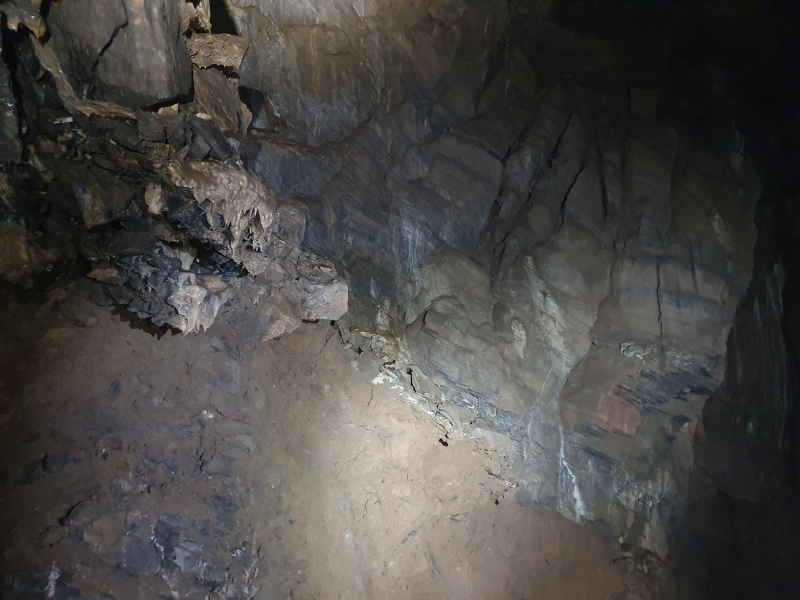
The side of the passage high up on the left showing the line between what has fallen and what is still clinging to the 'wall'.
Getting decent photos was hard, and the
ones here are just ones I was able to get on my phone camera. If Dave
and Graham got better ones on their cameras, I'll include in next
month's newsletter. Please don't be tempted to cross the tapes to take a
closer look at the debris pile. There could well be further falls from
the section of 'wall' on the left hand side of the passage (when going
downstream).
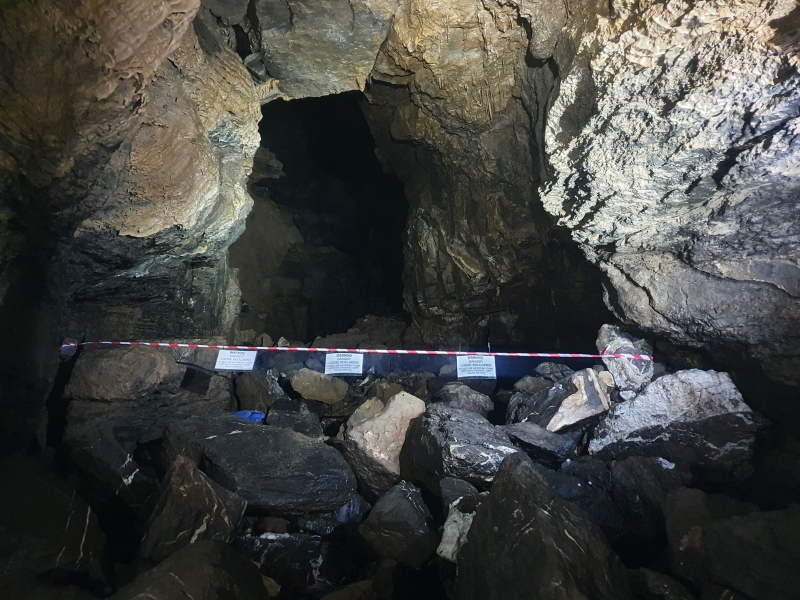
Taping outside the dropzone below the climb.
This is certainly the most dramatic natural
event to have occurred in the cave since the 1968 flood which spread
mud from the top of the Gorge to the Ladder Dig and it will take time
for winter water to in any way stabilise the area. We will be monitoring
for further movement in the area. Please, please if you see that tapes
and signs have been broken/removed, let me know so that these can be
replaced. And, as ever, be aware that caves can change without warning
and cave safe!
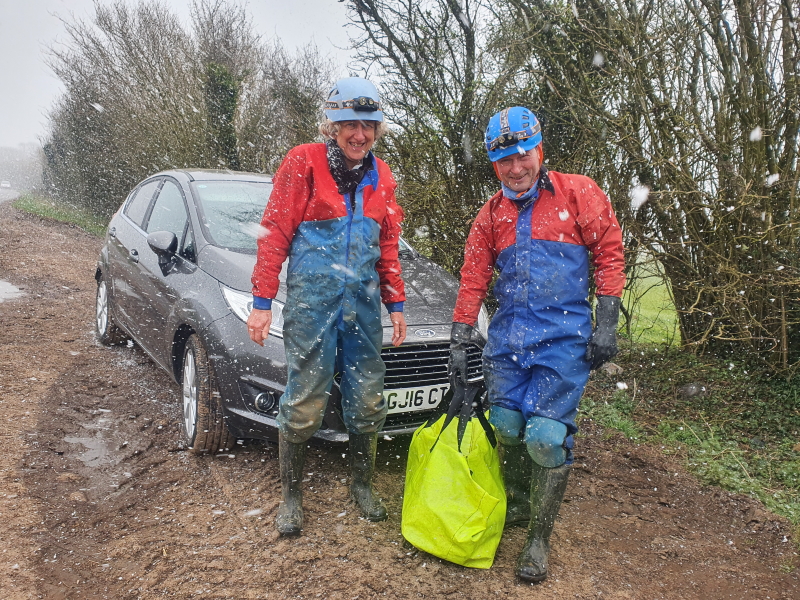
Helen and Clive very reluctantly posing for a photo!
We emerged nearly three hours later into a snowstorm! Yep, Mendip weather is that changeable!
Linda Wilson
|
|
AGM REPORT
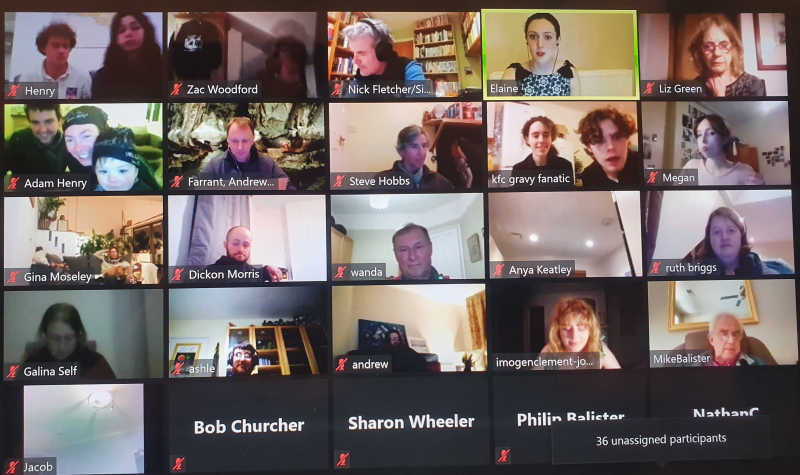
One Zoom screen chosen at random from many.
2021 became the first year in which the
society held a wholly virtual AGM, talk and after-party. Much to our
collective amazement, the evening went off without even our usual levels
of faff, possibly due to some very un-UBSS levels of Planning and
Preparation in the hope of Preventing Piss-Poor Performance. Not like us
at all. Rest assured, normal service has now resumed and we are back to
our Default Faff Setting.
A total of 53 (give or take a few) attended, comprising members, friends
and some Very Special Guests. After the opening remarks from the
Hon.Prezz, we were joined for five minutes by our first Special Guest.
Ozymandias Cronkshank, who later narrowly escaped being co-opted to
committee. His arrival was heralded by young Eddie Henry calling out,
"GOAT!" and later, when Ozzy's friends and family appeared, Eddie
demonstrated an enviable ability to count by then calling, "THREE
GOATS!" Any rumours that Graham is now training him up for the
Treasurer's role are most likely to be true.
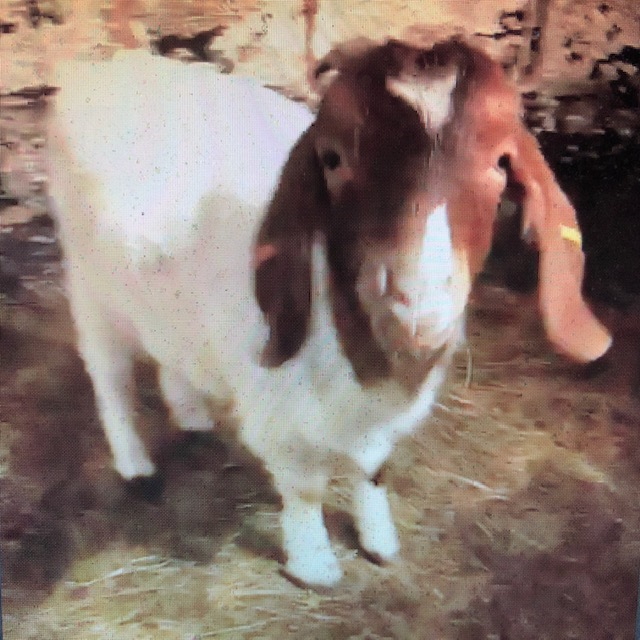
Ozymandias Cronkshank, Kid of Kids. Photo courtesy of Sharon Wheeler.
After that, the first item of business was,
under the new constitution, the election of 16 voting alumni for the
year. Naturally, we'd given no thought to process and no one had put
themselves forward, other than reserving voting positions for the Hon
Prezz, Hon Moneybags and the two non-student members on committee, so
people needed to be voluntold. Suggestions were promptly made, no one
ran away yelling "NO!" and it became a case of 'get picked on, then it's
your turn to pick' in best playground fashion, except for the lack of
unseemly squabbling.
The end result was that the following now have the vote for a year:
Andrew Atkinson, Ruth Briggs, Rosie Daniels, Andy Farrant, Ashley Gregg,
Sioned Haughton, John Hauser, Adam Henry, Steve Hobbs, Dickon Morris,
Gina Moseley, Graham Mullan, Elaine Oliver, Clive Owen, Steve Trudgill,
Linda Wilson. However, armed with this new found power, no one got the
chance to abuse it, as apart from the election of the committee, no
votes were held. But if an EGM is needed for any reason, these are now
the voting alumni reps for the year. For the avoidance of doubt, all
student members automatically have a vote.
The committee for the year consists of: Elaine Oliver (Hon President)
Henry Morgan (Student President), Andrew Atkinson, Cat Henry, Clive
Owen, Linda Wilson (Vice-Presidents), Merryn Matthews (Hon Secretary),
Graham Mullan (Hon Treasurer), Imogen Clement (Student Treasurer), Sam
Bowers, Megan Malpas, Zac Woodford, Nathan Cubitt, Sioned Haughton,
Ashley Gregg.
After the usual reports (which will appear in Proceedings), two new
members were elected: Nick Simons and Jan Walker. The Hon Moneybags
promptly demanded money with menaces and they both equally promptly paid
up.
After the formal business closed, everyone dispersed into a series of
Zoom breakout rooms for virtual cocktails and chat. At 8.15pm we were
joined by our second Special Guest, Rick Stanton, hero of the Thai cave
rescue, who was in quarantine in a hotel in Australia, there to work on
the film, 13 Lives, currently being made about the rescue. This stars
Viggo Mortensen (Aragorn from The Lord of the Rings) as Rick and Colin
Farrell as John Volanthen.
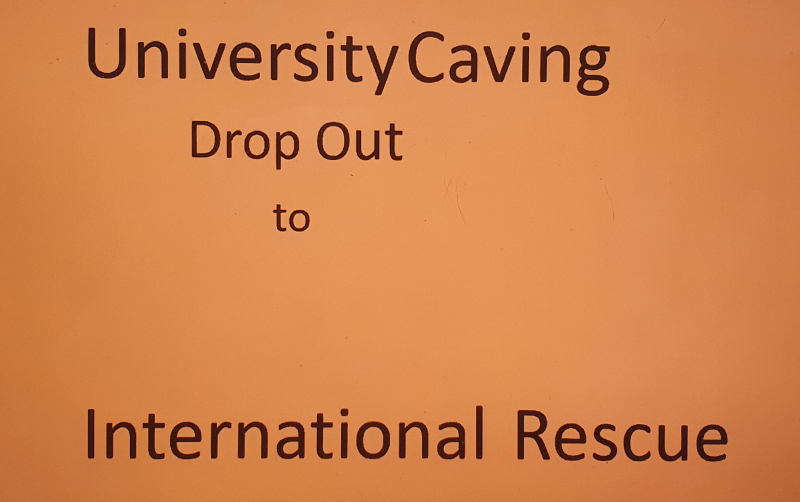
Rick's title slide, used with his kind permission.
For nearly 50 minutes, Rick took us on a
whistle-stop tour of his amazing caving and cave-diving career,
culminating in the behind-the-scenes story of the rescue that had the
entire world on the edge of its seat, that of the Wild Boars football
team and their young coach from the Tham Luang Caves in Thailand. For
those who missed Rick's talk, you'll soon be able to read the full story
in Rick's upcoming autobiography, Aquanaut, being published this summer
by Michael Joseph (a division of Penguin Random House).
After the talk, there was a lively Q&A with Rick, which went on as
long as the talk, with everyone who wanted to getting an opportunity to
ask a question. As recompense for giving up two hours of his time at
sparrowfart on a Sunday morning, Rick was promised a couple of UBSS
buffs, a keyring torch and a UBSS pen. Looking suitably gratified, he
was heard to remark that the goat got paid more than he did. True fact.
It's also a true fact that Eddie Henry didn't yell: "RICK STANTON!" when
our hero appeared in the screen. However, we've now been informed that
Ozymandias Cronkshank has been offered a part in the hotly awaited
Broadway musical of the rescue, playing Rick, in a shameless attempt to
appeal to the younger audience. His agent says that Ozzy is willing to
shave his hair off for the part, just as Mr Mortensen has done. The trio
are said to be getting along famously.
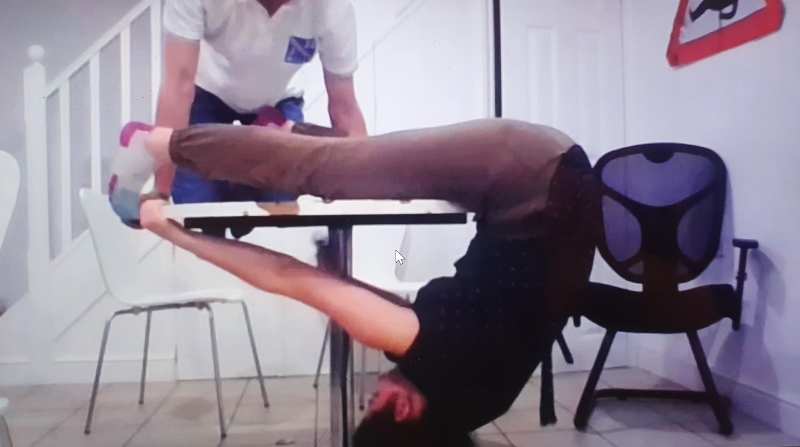
Mia practising Goat Yoga. Unfortunately, it was well past Ozzy's bedtime, so Henry had to take his place.
When Rick was finally allowed to get his
much delayed breakfast, everyone scattered into breakout rooms again for
the rest of the evening, gradually all coalescing into a party in
which, in the time-honoured manner, there was table traversing, pole
dancing and general piss-taking.
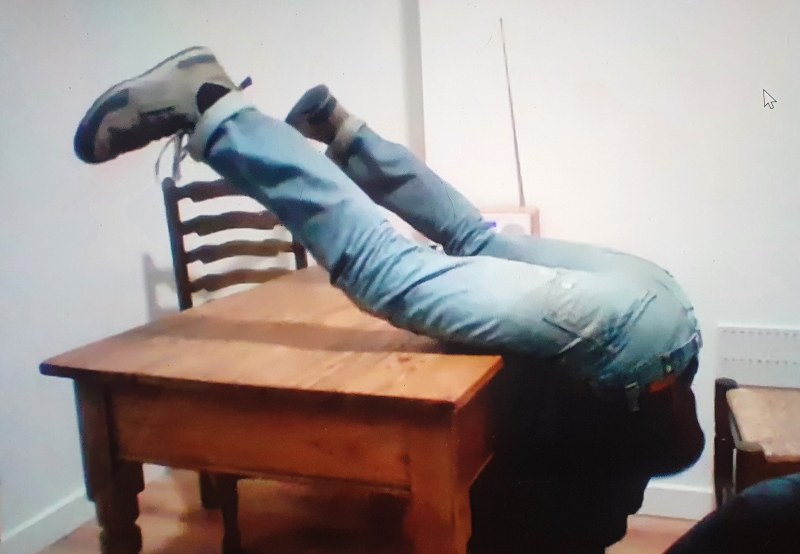
Dickon, looking for a goat.
The party finally broke up around 2am. Many
thanks to Rick for accepting our invitation to talk at the AGM and for
helping make our first Zoom AGM a huge success. Just don't expect anyone
quite so famous next year!
|
|
A NOTE FROM THE HON. MONEYBAGS

This has been a very strange year for the
Society as a whole, not just for its finances. They, as can be imagined,
have behaved quite unusually. There has been little productive
speleology, but we have had significant and unusual expense in a couple
of areas, notably to do with the Hut and with the Museum and Library.
However, two things have conspired to keep us on the straight and
narrow, financially. The first is the continued support of our
membership. We have maintained our income from subscriptions and the
additional tax rebate that they bring in as well. For this we remain
grateful. The second is that, thanks to the Society paying business
rates on the Hut, we were in receipt of a significant government grant
at the beginning of the financial year. This came with no strings
attached. The committee resolved to use this in ways to allieviate the
additional financial burden that covid has placed on us. This has
enabled us to cover expenses on our infrastructure (eg paying a local
caver to work on the chimney at a time when it was difficult for us to
undertake work there) and much remains in hand to support student
activities in various ways once these can recommence (eg increased
travel or accommodation costs).
So the accounts for the year pretty much consist of unusual expenditure
in some categories and me shovelling grant money at them to keep them on
an even keel.
In other news, The Caves of Mid-West Ireland has almost broken even. It
would probably have done so by the end of the year, had not the Zombie
Apocalypse got in the way. Bear in mind, however, that this is in net
terms and is only the case owing to the significant grant funding that
book received from Ireland. The companion volume on Southern Ireland is
progressing steadily, but again, necessary fieldwork has been somewhat
disrupted.
Graham Mullan
|
|
UBSS IN UNIVERSITY CHALLENGE!
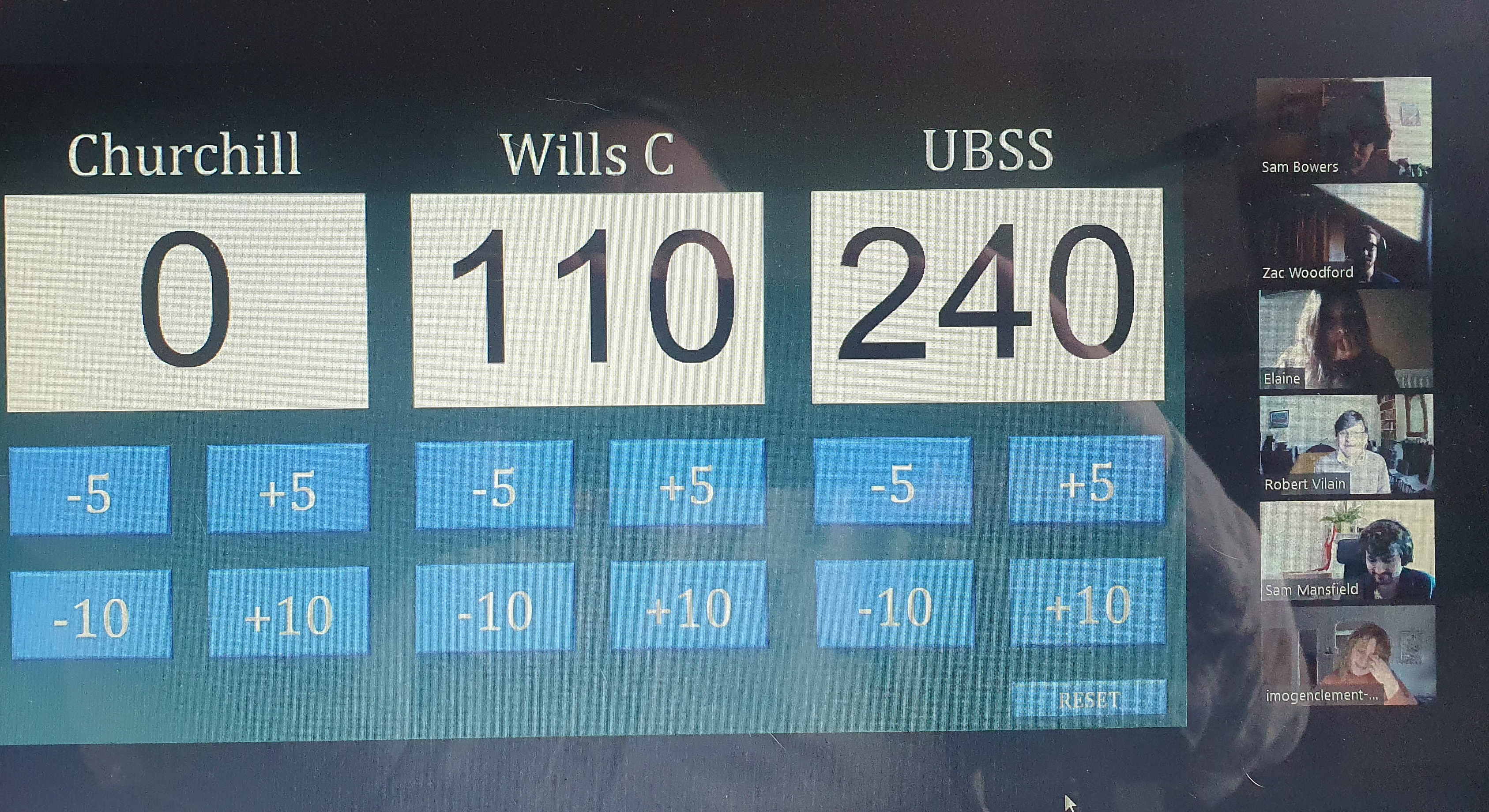
As part of the Alumni Network
Spring Showcase event, a University Challenge style quiz attracted a lot
of interest, and after a year of zoom quizzes, this wasn't an
opportunity to be missed.
Sam Bowers put out together a team made up of himself, Elaine Oliver,
Imogen Clement and Zac Woodford. In the first heat, they stomped to a
very convincing victory over a team of students from Wills Hall (the
Churchill Hall team were a no show on the day) to reach the semi finals.
Zac's knowledge of Star Wars came in very handy with everyone making a
very strong showing with an impressive array of eclectic and very random
knowledge, including correctly identifying photos of several of the
world's leading museums.
In the semi finals, they were unlucky to run up against a strong (but
very annoying) team from Cambridge, the Cambridge Anglians, who got all
the questions the UBSS team should have got, including one on wine
regions of France, which would have provided a clean sweep of correct
answers. Sadly, the Cambridge team emerged the victors, but UBSS had
their revenge when the Anglians faced another Cambridge team, the
Cambridge Blues, which included UBSS member, Steve Trudgill. The Blues
streaked to a convincing win, despite our former geographer at one point
declaring loudly: "I don't do real geography!" which he promptly proved
by knowing absolutely nothing about the geography of the United States.
All the contests were recorded, so if you would like to watch and see
how well you would have done, drop us a line and we'll provide the link
to the recording. It was all great fun, done with buzzers, the theme
music and a scoreboard. Robert Vilain made an excellent quizmaster, with
a flawless combination of Bamber Grassgroin and Jeremy Maxo all rolled
into one very erudite whole.
The showcase team are intending to hold the event again, and another uni
challenge quiz is on the cards, so UBSS will have the change to field
several teams and exact our revenge.
|
|
FROLICS IN THE FOREST

A (younger) Dick Willis looking lost in the middle of the Thai forest. All
photos are from Dick's slide collection and were scanned by him for
this. They have been cropped where needed and resized for this article.
As part of our campaign to
encourage members to commit as many caving memories to print as
possible, Dick Willis has kindly obliged again, and talks here about an
expedition to Thailand.
The phone went, Dave Checkley, “Fancy a trip to Thailand?” A stupid
question, of course I did. “When?” “March.” “Who’s going?” “Me, Phil
[Chapman], H [Howard Jones], Sheila [Hurd]; all great people and good
company. “To do what?” “There’s some forest in the north east with good
potential, nothing deep but there should be lots of caves. A French team
went there last year but got chased out by elephants, one of their
porters died of heat stroke.”
Forest, caves, elephants and the French had failed. It sounded perfect. “Yes, please.”
Bangkok. An uneventful flight via Pakistan, apart from the Karachi
police confiscating all batteries. We found a cheap hotel and headed
downtown in the bustle, pollution, people, hookers, street sellers and
excellent food. The next day, Phil and DC went to the museum, Phil
wanted to know if they would like him to collect specimens of any cave
fauna that we found. The two came back grinning like schoolkids. “We
told our contact where we were going, and he told us it was the Phu
Khieo wildlife sanctuary which was set up at the overlap of three
national parks. together they cover 320,000ha. It has elephants, tigers
and was the last place where rhino were recorded; it sounds wonderful.
The bad news is that it’s closed, you need special permission to enter
it and the army patrols the perimeter. But he said that he thought the
Deputy Warden was in the building, he found him and introduced us. We
told him what we wanted to do, he thought it was a great idea and wrote a
note about it to the Warden.” DC grinned and waved a letter which was
in Thai script and could have said ‘arrest them on sight’, but it was
enough, and we were off.
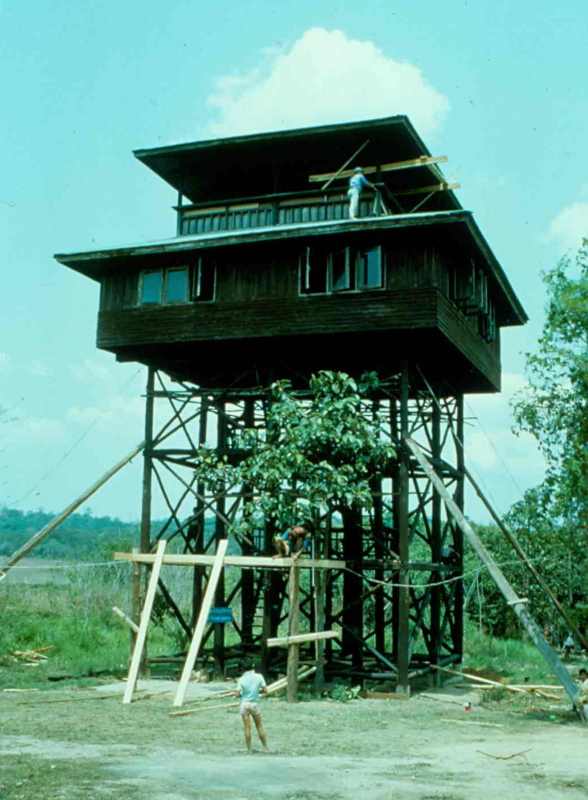
The Kings Tower
Two days later we were on a
bus to Pang Mung and as we approached the town a limestone scarp was
visible in the distance. We found a taxi driver to take us to the
sanctuary HQ. He was desperately keen to get in because his family had
been turfed off their land when the sanctuary had been created and he
had never been back. At the army checkpoint, we waved our letter at the
squaddie on duty and were waved through. We bumped down a long dirt
track to what had been the village and was now the HQ and research
centre. Off to one side was a helicopter pad, villa and observation
tower all reserved for the King on his visits.
In most Asian countries, bureaucracy rules supreme but our letter was
like a magician’s wand. We presented it and were welcomed. The warden
could not have been more helpful and arranged for us to have an
English-speaking liaison officer, a translator, two armed guards and a
porter. We were told that the guards were there to protect us from
elephants and tigers, but it quickly became apparent that the main
reason was to protect us from armed poachers. Indeed, one of our guards,
an older man called Khampun, was a reformed poacher himself. There
definitely were big animals in the forest around us but, to be honest,
the main wildlife threats came from leeches, mosquitoes, and ticks.
We spent a couple of days sorting out gear, teaching our companions the
rudiments of SRT and getting supplies. Then we left for the forest. For a
biologist, even one as useless as me, the place was wonderful, ruins
were covered in tangled tree roots, birds were calling constantly and
the first muddy area we crossed had the prints of elephant and tiger.
Walking across one clearing, we could smell the elephant and I had no
doubt that they were hiding in the bush watching us, although I have
never worked out how an animal that big could be so inconspicuous.
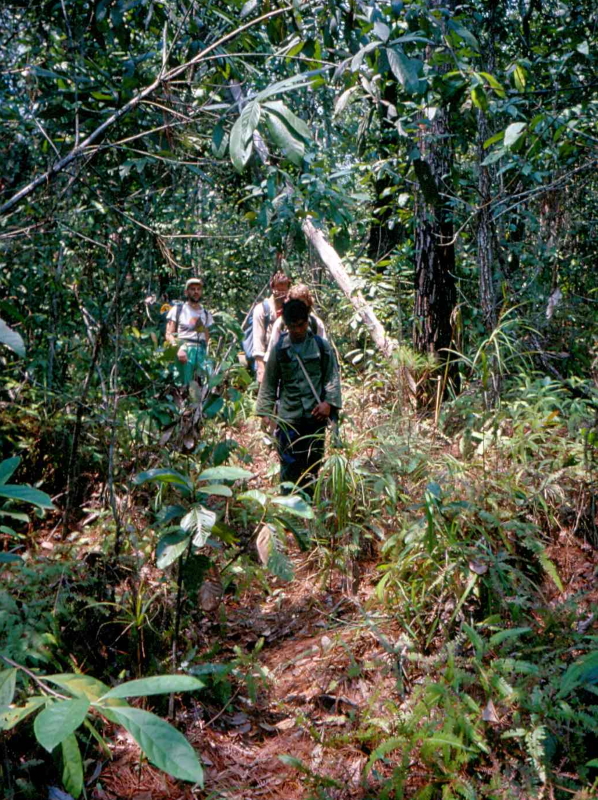
Cave hunting
We made camp in a gorgeous
area of open forest, on an area of flat ground alongside a stream. At
one end of our pitch was a bamboo grove with an obvious tiger-sized hole
in it. So we insisted that H set up his bivvy tent at that end while
the rest of us rigged a big camp-sheet and put our karrimats and
mosquito nets underneath it. If I tiger came out, it would get him
first.
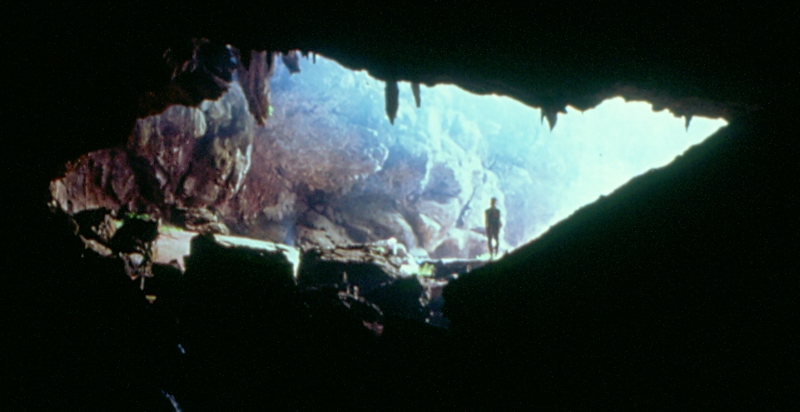
A typical entrance
What we didn’t notice was a bees’ nest in
the riverbank behind us, or maybe they weren’t there when we arrived,
but over the next few days they became a greater and greater problem.
You’d wake up in the morning to find your mosquito net crawling with
bees and we developed a procrastination game which involved flicking a
bee from underneath so that it went up, bounced off the fly sheet and
landed angrily on someone else’s net. Getting up involved a mad dash to
get into the fire smoke, where there was some respite from them and had a
chance of getting into your gear without it filling with the insects.
Although on one occasion I was stung on a very tender part of my
anatomy, much to my colleagues’ great entertainment.
Fortunately, no tigers appeared although one night several members of
the team heard what sounded like a large animal breathing heavily
nearby. While we were there, every move was watched by a family of
gibbons in the bamboos across the stream and we were woken by their
calls each morning, an astonishingly haunting sound that still reduces
me to tears.
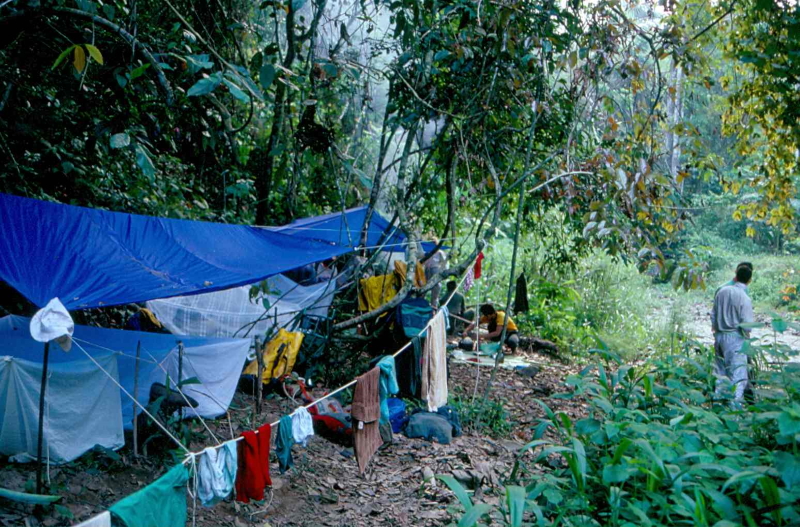 Streamside camp Streamside camp
There were high points in
the reserve from which we could get a view of our surroundings but
getting up them was a struggle, steep pathless ascents up through bamboo
groves. And finding anything that we had seen became a huge challenge
once we were back down on the plain.
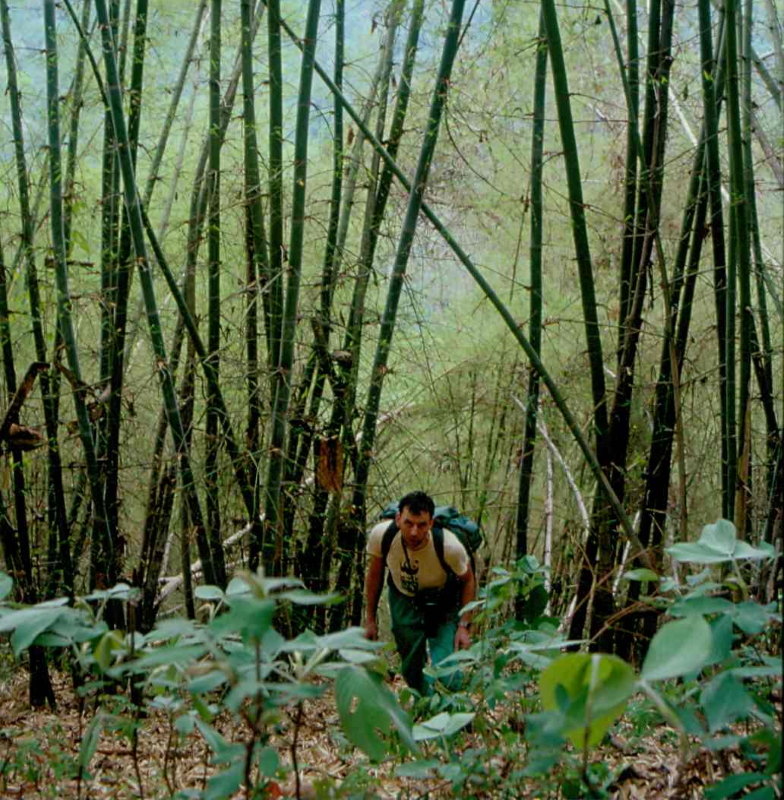
Phil Chapman looking tired.
Our new campsite was in a
defile which led down to a clearing with a cliff-face at the far end.
This clearing had once been a banana plantation and the evidence of
elephant was everywhere – footprints, trampled trees, and huge balls of
fresh, fragrant shit. Our camp was right on their path in and we hoped
that we wouldn’t get a visit. At the foot of the cliff was a sink
entrance that looked inviting and over the next couple of days Sheila
and I concentrated on pushing it as far as we could go while the others
looked into systems elsewhere. Our cave, Swallow Cave, Tham Nok Nang Hu,
was heaving with wildlife – the walls were covered in crickets and
centipedes, snakes slid away from us and on one occasion, Sheila turned a
corner and leapt backwards shouting “a duck, a duck”. As we were quite a
long way from the entrance, in a dry passage and at least 30m below
ground level, this seemed unlikely (my 3 years at Bristol studying
zoology hadn’t been entirely wasted) so I peered around the corner.
Ahead of me was a rock shelf and, sitting on it looking distinctly
grumpy, was a porcupine.
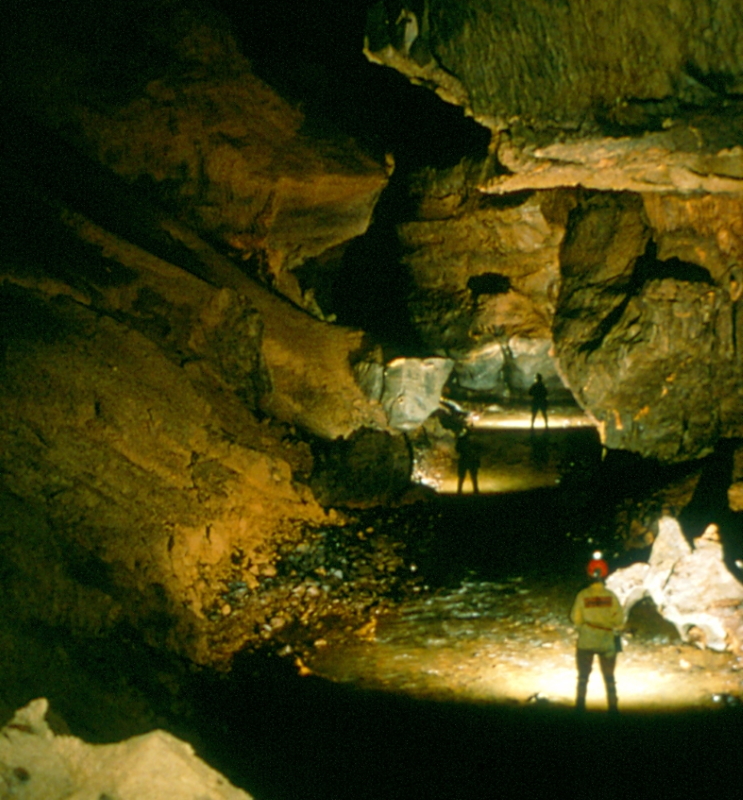
Swallow Cave passage
Porcupines look nothing
like ducks, and I found this hysterically funny. I was laughing so much
that I had to put my arm out and lean on the wall, but mirth turned to
horror when I felt something run up my arm. It might have been a
harmless cricket, but it could well have been a Scolopendra centipede,
nasty beasts which are renowned for their toxic bite. If so, I knew that
a bite was unlikely to kill me, but it would certainly have spoilt my
day, probably several days, and it was now sitting on the inside edge of
my bicep. I was surprised it didn’t just drop off because I was
sweating so much with fear.
“Take off your boiler suit,” Sheila advised (after having a good laugh
at my plight) but to do that would have disturbed my guest and almost
certainly resulted in a bite. After a couple of minutes of panic, I
grabbed the beast, fabric and all, and scrunched it hard, working on the
assumption that I could kill it before it worked out what was
happening. I cleaned off the resulting mess without ever knowing what it
had been.
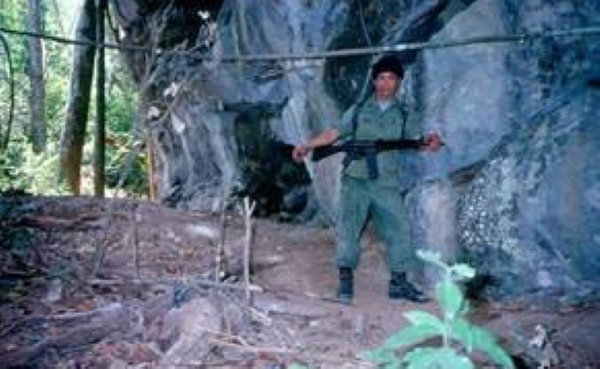
Khampun; the gun went caving
Getting back to camp in the
evening was a relief, we found Khampun cooking an evening stew, well
stocked with meat – local frogs – flavoured with a lot of chilli. There
was a stream flowing down the defile and a short distance away was a
pool where we could have a good wash. But that wasn’t a relaxing
experience. The sides of the defile were about 2m high and the bush
above us provided perfect cover for a hungry tiger out after dark and
looking for an easy meal. We knew that they were in the area, not only
had we seen their prints but both DC and Phil had been convinced that
they had seen tigers moving away from them in thick undergrowth. And in
places there were scratch marks on tree trunks about 3m above ground…
Fortunately, washes were never interrupted by big cats, but our nights
were often disturbed by gunshots – there was a real problem with
poachers. They infiltrated the park looking for elephant and tiger – the
latter’s body parts being worth a small fortune in the trade for
Chinese medicine – or deer for food. Their technique was to set up a
series of small, crude bamboo ‘traps’ along a trail and then sit at the
foot of one of the huge trees whose buttress roots provided perfect
cover. The traps didn’t catch anything, they just made a discernible
click when triggered. The poacher would sit for hours in the dark with
their gun pointed at the last trap – any large animal approaching would
trigger the traps; the poacher would count and fire when the last one
went click. The target could have been anything, including a tired caver
coming back late at night.
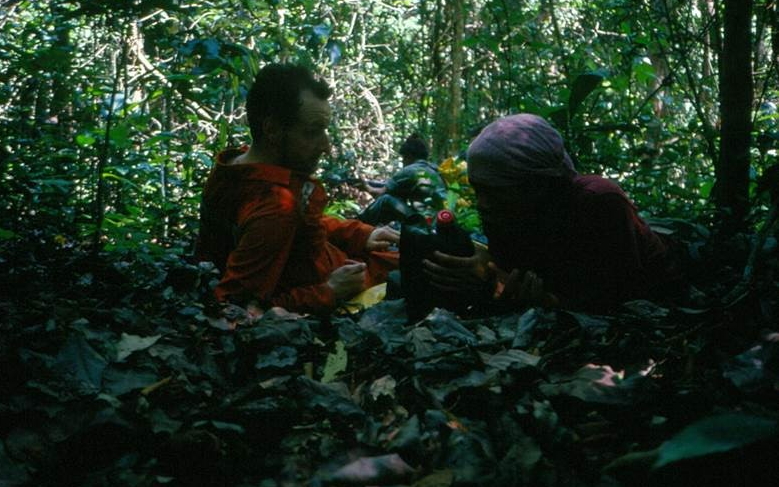
Howard and Pradeet, hiding
On one occasion, H and I
set off to go to the northern end of the reserve for a recce. We had our
interpreter, Pradeet, with us and two armed guards; Khampun was at the
front. Our path took us through a fabulous area of forest, huge trees
covered with dried mud where elephant had scratched against them. I
became aware of Khampun getting slower and slower. “Why are we slowing
down?” I asked Pradeet. “Because there are poachers ahead of us,” came
the reply. The path turned and we found a large tree trunk lying across
it, from behind came a wisp of smoke. Khampun, studied the fire and
carried on even more slowly, holding his rifle at the ready. Suddenly he
shouted and fired off two shots into the bush and we could see two men
running away, both carrying guns.
H and I followed the example of all good war movies and threw ourselves
onto the floor as our guards knelt, guns ready, scanning the forest. I
was suddenly aware that I was wearing an orange boiler suit, a perfect
target. Pradeet said something to Khampun who carefully lifted a washbag
out of his sac and threw it over. “Pradeet must be hurt,” I thought as
he fiddled around. But instead of a plaster, he took out the biggest
pistol I had ever seen.
We never really had a chance to check out the north end, although I dare
say that it has been looked at by now. There are a lot of ex-pat
British cavers in Thailand, not to mention Thai cavers themselves. There
was one more attempt by DC and Sheila who found a stream sink with the
water going down through boulders. Sheila waited on the surface while
Dave squirmed down following the water. Eventually he gave up and turned
back, but what had been an easy route down, following the stream, was
now a complex of rivulets and the way back was anything but clear.
Eventually, by following Sheila’s shouts, he found a way out, but he was
clearly shaken and swore he’d never make the same mistake again.
At the end of the trip, we had a couple of days to spare and made the
decision to go to a beach for a spell of R&R. As good, clean living
young cavers we had no advance knowledge of Thailand’s good-time
reputation and boarded a bus to Pattaya, the nearest beach. We were all a
bit perplexed by the passenger demographics, the bus was full of young
people, about 75% of whom were women. We arrived after dark, lugged our
sacs to the nearest decent looking hotel, checked in and crashed out. In
the morning, I opened the curtains and looked out across the lawn to a
strip of palm trees, a beach, blue ocean and… the US 7th Fleet. It was in for a few days rest and recreation.
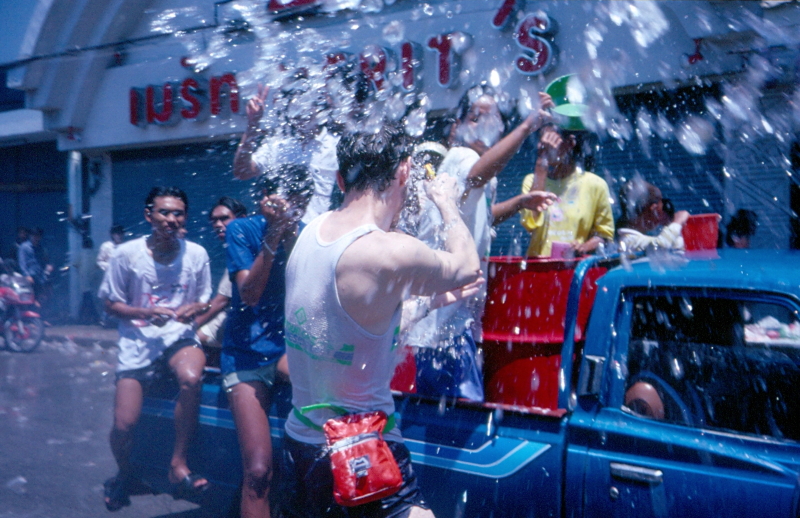
Howard entering into the spirit of Songkran
Unbeknown to us, the
Pattaya Council had delayed the annual Songkran festival to coincide
with the Fleet’s visit and the town had prepared accordingly. We went
out, found a café and sat in a line at a long peninsula unit, opposite
three huge American guys in shades. One of them looked at me and asked,
“are you guys limeys?” I nodded my response and watched him reach down
to his sides. As the theme tune of ‘For a Few Dollars More’ played in my
head, he pulled up two guns, pointed them at me and pulled the
triggers. I was immediately drenched and from behind me, one of the bar
girls tipped a bucket of ice water over my head.
Thus began two days of the most fabulous mayhem I have ever encountered
as we shared Pattaya with 7,000 marines and 15,000 hookers, drenched
everywhere we went and plastered with chalk paste. Absolutely fantastic.
Dick Willis
|
|
SAMPLING IN ST VINCENT'S SPRING
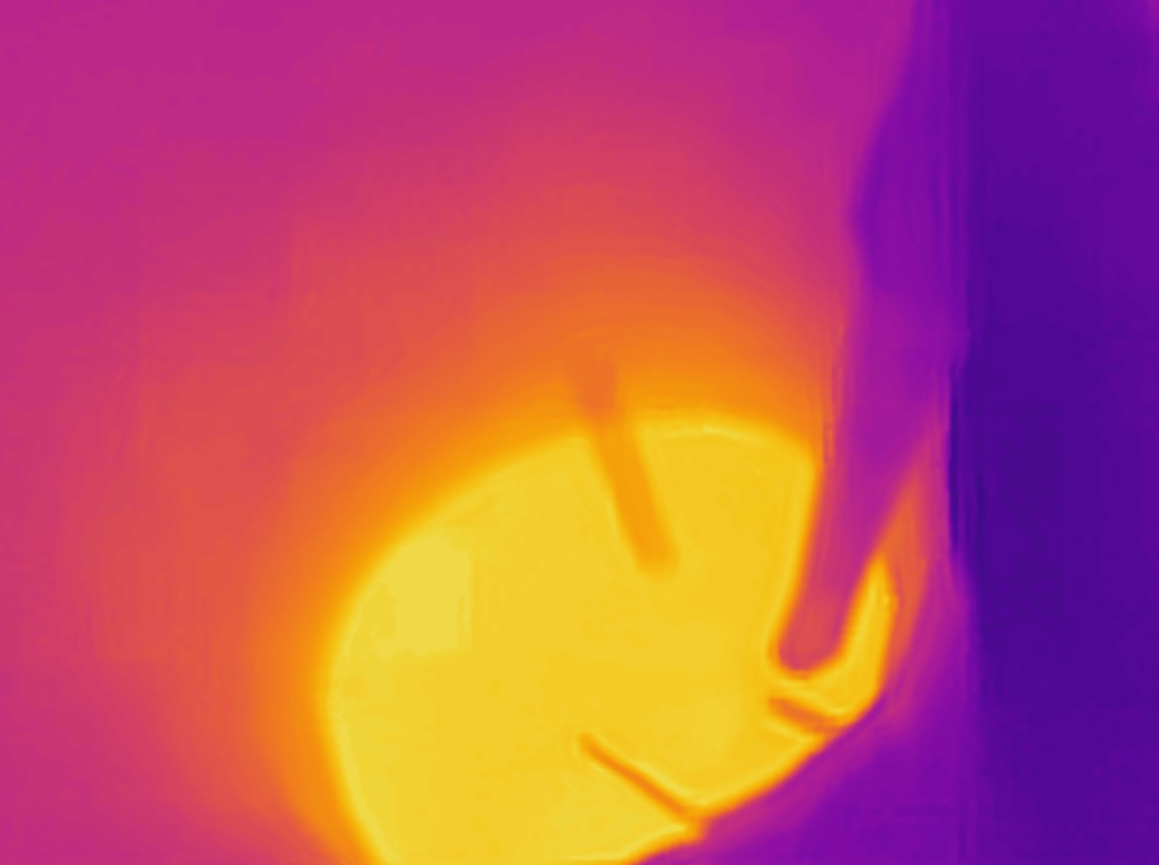
Nope, it's not the result of a Jamboard art
session, nor is the thing on the right what you think it is! Minds out
of the gutter, folks, this is SCIENCE! See below. Photo by David Richards.
Work in St Vincent's Spring on the
Portway continues, as David Richards explains. On any visit to the site
please a) take HUGE care when approaching the cave across the road
b) please do not disturb any of the monitoring equipment c) don't fall
down the well. If the latter happens, the piss-taking will last well
beyond the end of your natural life.
Over the course of the past 14 months,
various UBSS members have periodically visited St. Vincents (New
Hotwell) Spring to collect temperature and water level data from
the mildly thermal (21 ± 1 °C) waters. Former UoB lecturer in
biochemistry, Dr. Paul Wood, has pulled together much of the industrial
archaeology associated with this site and prompted the current
hydrological ongoing investigation. Data loggers have been
installed to monitor temperature and water levels every 10 minutes since
November 2020 (thanks to British Geological Survey, Cardiff, for loan
of the water level loggers). Late February was the latest venture
to check that the loggers remained in place and to download three months
of data.
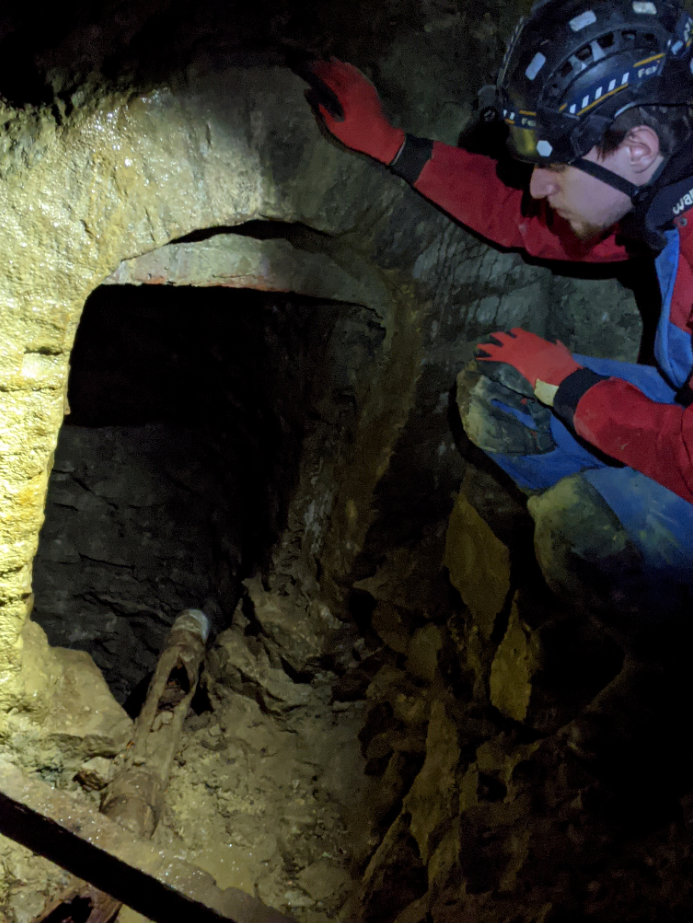
Zac Woodford above the well shaft of St. Vincent's spring. Photo by David Richards.
The temperature of the water is likely to
be a function of input from recent heavy rainfall (short residence
times), tidal waters (semi diurnal), shallow groundwater (longer
residence time), and the geothermal component (up to thousands of
years). In time, we hope to be able to deconvolve the signal
having now monitored water levels also. It would appear that heavy
rainfall can reduce temperatures during the winter by 1 °C, yet we
also see a longer-term increase in the temperature of the well during
the winter (with inverse response for cave air temperatures). When
we next collect data in early summer, we will also be able to see
the (?lagged) impact of the highest Spring tides on the
water.
The colourful header photo shows temperatures based on infra-red signal
using FLIR ONE for iOS Personal Thermal Imager. A max temperature of 21
°C is shown in the above image. Pipes (now broken) originally supplied
water to holding tank above pump on the Portway.
With thanks to Linda Wilson, Graham Mullan, Jan Walker, Tony Boycott,
Andrew Atkinson, Sioned Haughton and Zac Woodford for their help with
this research.
David Richards
|
|
WHY IS THE WATER BLUE? A MEMORY OF SINGING RIVER MINE
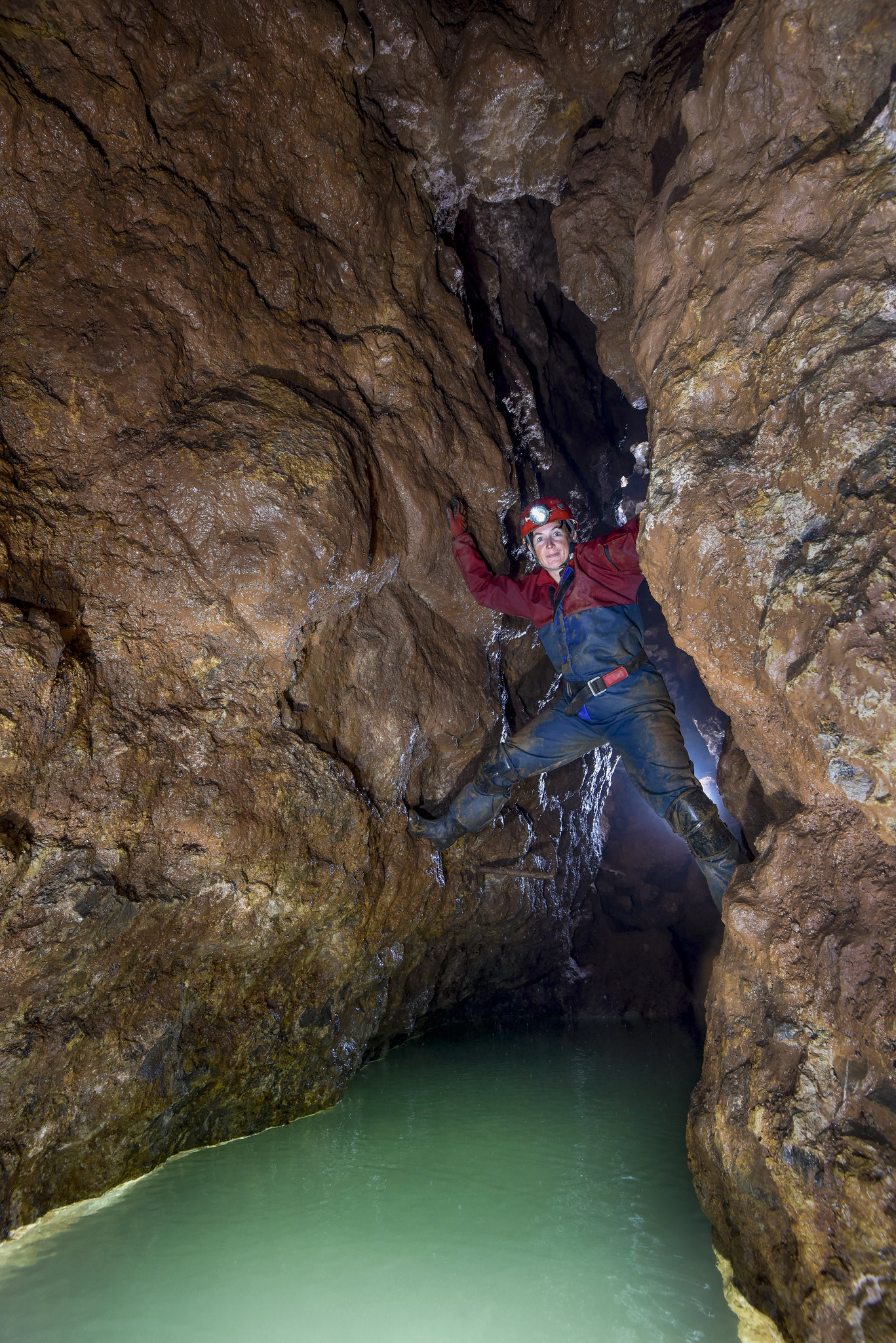
Singing River Mine. Photo copyright Mark Burkey, used with his kind permission. Er, the water looks green here...
Readers with good memories might
recall an exchange in the I Read to the End comments a couple of months
ago between Ian Wheeler and Andy Farrant over whether Andy did any
dye-tracing many years ago in Mendip's Singing River Mine, a popular
UBSS haunt over the years. Ian has done some memory checking, and takes
up the tale again ....
This month’s newsletter with its gushing over Doctor Farrant reminded me
that he had cast aspersions over the veracity over my story about
Singing River Mine in a previous issue, so I will elaborate.
I remember my first trip down Singing River at the end of my first year
(the local pub was great – it served pickled eggs in a shot glass, you
could play blow darts and it did a really nice pint of Butcombe. I once
wrote a throwaway line about the village of Butcombe into a play I wrote
and my director told me it was yet another piece of juvenile filth that
she wanted to cut and I had to show her it on a map to keep the line.
It was, of course, inessential juvenile filth, but it’s the small things
you have to fight for… I digress.) [Editors: we'd like to see an
extract from this play for a future issue. Our readership is drawn to
juvenile filth!]
In the big chamber in Singing River, we
were all very taken by the colour of the water, which was a lovely blue
colour. For weeks, we would pester Andy in the pub. “Why is water blue,
oh wise Dr Farrant?” we would ask plaintively. (Was he a Doctor by then?
Probably not… poetic licence.) In the end he got very cross and told us
that the water in Singing River was blue because water was blue and
that was an end to the matter.
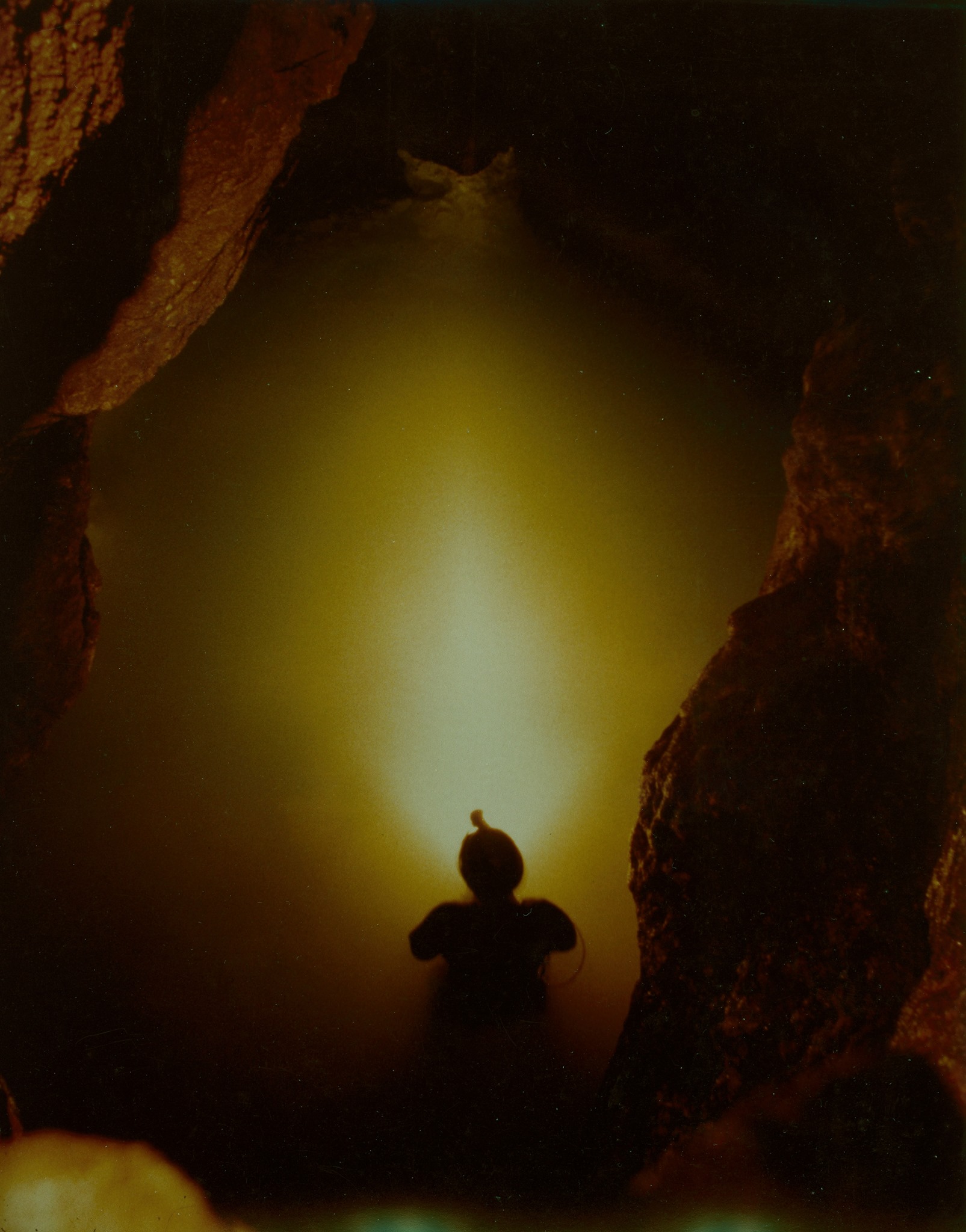
Singing River Mine. Photo copyright Kay Wills, used with her kind permission. Er, doesn't look blue here, either...
This didn’t seem true, even to an idiot
English student, so we made him come with us on a trip down the mine so
we could ask him again (and again…. And again) why the water took such a
blue hue.
Infuriated by our asinine questioning, he had already planned his
revenge and dumped fluorescein in the streamway to enchant and confound
us in equal measure.
I have checked this memory with Rupert Hay-Campbell and he is happy to
confirm the tale and also reckons it was green rather than the red that
was sometimes to be found in the tackle store in those days. As he has
an MBE, his memory is obviously beyond reproach and I hope this goes
some way to setting everyone’s mind at rest.
Ian Wheeler
[Editorial PS: We are most happy to grant
the said Dr Farrant the right of reply, as that'll give us more material
for the next issue, along with the extract from Ian's play referred to
above.]
|
|
ANAGRAM COMPETITION!
Mia and Henry recently put together a
fiendishly difficult quiz with a round on caving anagrams, so for those
who didn't make it to the quiz, here's the anagram round, with a prize
for the fast set of correct entries. For those who were there, we know who you are!
1. RIPEER SPOT
2. LITTLED COW ASS
3. ROWMAN FART SMELL
4. SPOD TOR
5. COOCHIE LAGER CAVVR
6. LANED DEW LAG
7. PROG THOR FOY
So get your thinking helmets on and email Mia with your answers!
|
|
THE WET SINK (SLAUGHTER STREAM CAVE) SCIENCE PROJECT STATUS
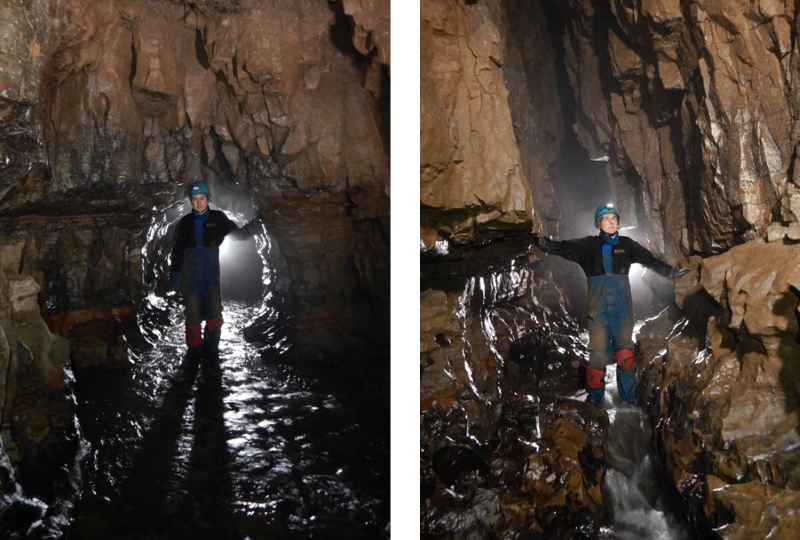
The main stream near Cross-Stream Junction, Slaughter Stream Cave
Mark Tringham has been working for
some time in Slaughter Stream Cave, and in this article, he gives an
overview of scientific work in the cave.
Introduction
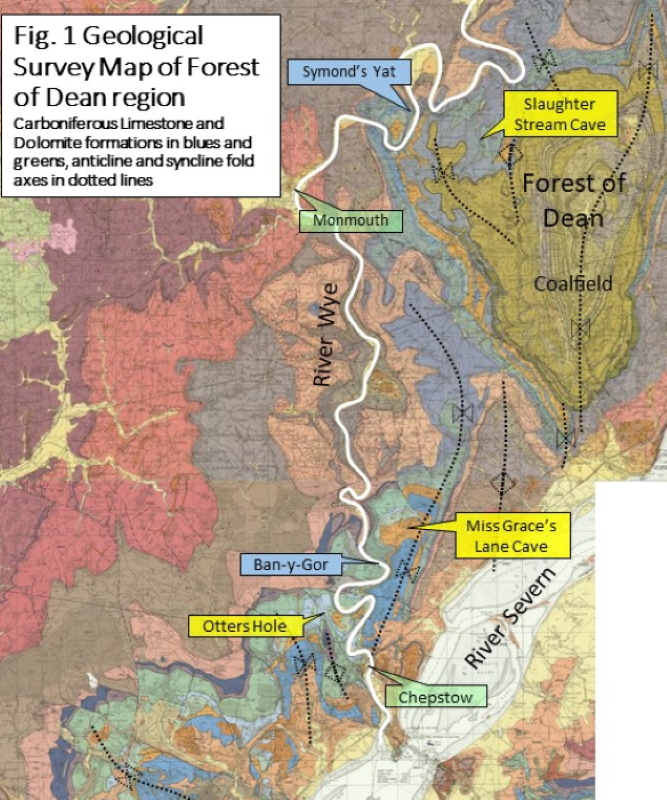
Historically in British caving the Forest
of Dean (FOD for short) was mostly seen as a region without much cave
potential and generally not worth the detour on the way to other more
interesting regions like South Wales or Derbyshire, unless you were
interested in disused iron or coal mines. However, with tenacious
digging and water tracing work significant discoveries were made.
Firstly at Otter Hole near Chepstow around 1974 (~3.5km), arguably the
UK’s most beautiful cave and with an enigmatic and hazardous tidal sump
close to the very muddy River Wye. Then another break-through occurred
in 1990 at Wet Sink, not far from the beauty spot of Symond’s Yat, again
close to the River Wye, but a long way upstream from Chepstow. This
allowed access for the first time into the Slaughter Stream Cave system,
which today totals around 13km. More of national significance is likely
yet to come from digging and water-tracing in another FOD area, the
Tidenham Chase Syncline, where Miss Grace’s Lane Swallet (4.5km) and
other sinks feed down several km to a resurgence at Ban-y-gor, a few
kilometres upstream and on the opposite bank of the River Wye from
Otters Hole.
The Slaughter Stream Cave
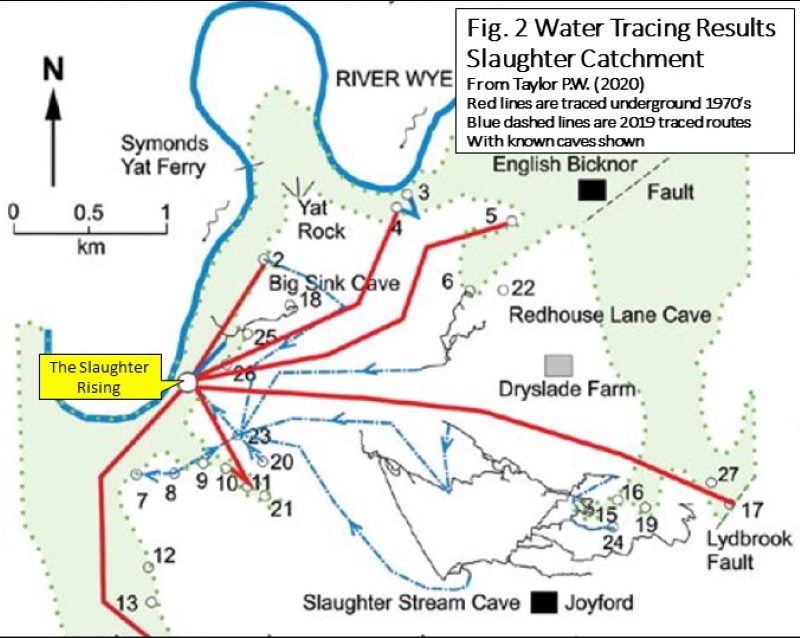
The Slaughter Stream Cave (SSC) forms a 13km long system with several
active and relict passages with streams that flow generally westwards
from several surface sinks down to the Slaughter rising on the banks of
the River Wye. Despite numerous digs spread around the cave catchment
area the cave presently has only the one entrance at Wet Sink. Here the
passages quickly descend to ~55m depth, spiralling down several short
pitches and joining a gently sloping main streamway. This then generally
follows the gentle stratal dip for several km to a maximum depth of ~
110m at Sump 4. However, there is extra complexity because in many
places relict dry passages occur at different levels at up to ~35m
higher than the active streamways. These relict passages commonly have
significant quantities of sandy sediment fill and boulder break-down,
attesting to a long and complex speleogenesis likely spanning several
periglacial and inter-glacial periods. Cryogenic calcite deposits have
already been noted in some relict areas of the cave and these must have
formed during glacial or periglacial periods with permafrost extending
50m or more below the surface.
Since the cave was discovered attempts at significant scientific
research failed to materialise despite the best efforts by Paul Taylor
(GSS) and others to stimulate academic interest. Around the year 2000
for example two PhD students were lined up and had support from the DJ
Lowe at the Geological Survey and local academic Nick Chidlaw, but then
the potential students backed out, perhaps because they realised the
complexity and logistical challenges in front of them. This left little
understanding of the cave morphology, hydrology, geology and
speleogenesis for several decades. However, in 2018 a new phase of GSS
sponsored scientific work started, initially with a water tracing study,
but then expanded to include resurveying, speleogenesis and geological
work as described below.
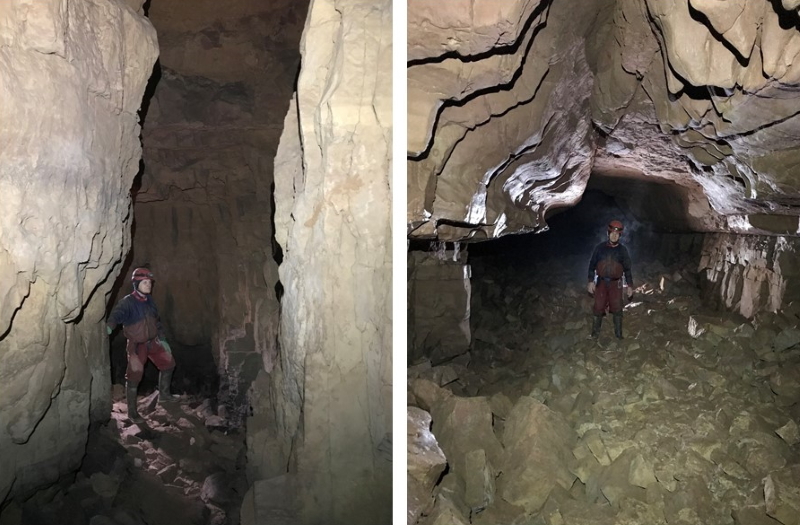
Dryslade Passage (left). Chunnel West (right)
Furthest parts of the cave take ~ 5 hours
to reach, with some fairly strenuous scambling and crawling. Therefore
during the present phase of surveying and scientific study some
underground bivouac camping is planned so that 10 to 15 hour trips
can be split between more than one day.
Hydrology
The existence of a Slaughter Cave system
was postulated as early as the 1960’s prior to it’s discovery by digging
at Wet Sink. The Cave Projects Group performed water tracing projects
in the 1960’s and 70’s, the results from which were published by Solari
R.A. (1974) & Lowe D.J. (1989). These showed a surface and
underground catchment area of approximately 6km^2 and nearly 150m
relief, with many surface sinks feeding water to the Slaughter rising on
the banks of the river Wye and to two other more minor springs. Despite
the SSC system discovery and exploration there was then a major gap in
water-tracing efforts until early 2018 when a new project was started
and this is still underway. The intent is to try and solve questions
about stream flows seen both within the SSC and other nearby caves and
again from the various surface sinks. The history of investigation,
methodology and preliminary results have been reported by Taylor P.W.
(2020) and in recent GSS Newsletters and in the Descent magazine.
Further water traces remain to be done, with for example a bigger
fluorescene load dropped into Hoarthorns Wood Swallet (the furthest
known upstream sink in the system) to try and get a positive trace to
somewhere inside the cave and perhaps confirm a postulated link to the
downstream end of Sump 1 in the Drake Series which divers had entered
but not successfully passed.
Previous Surveying
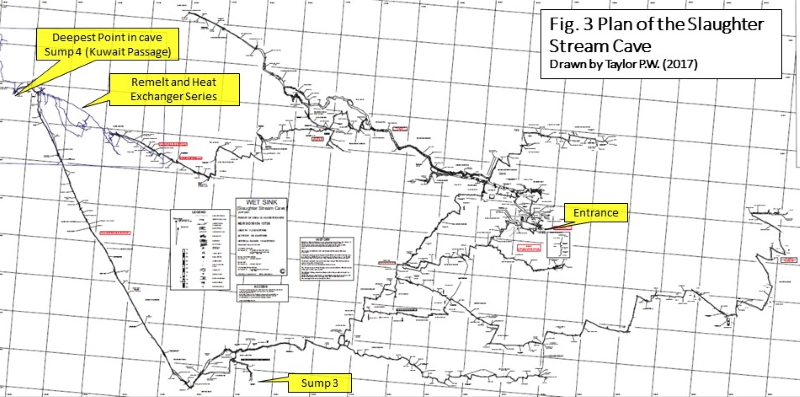
The present scientific projects need to be based on adequate digital
cave morphology with not only plan views but also passage cross-sections
and elevations. Also, 2D and 3D displays are needed to integrate with
surface topography and mapped geology. The initial cave discoveries
(~11km) were well surveyed mostly around 1991 to 1993 with a lot of hard
work put in by GSS and RFDCC using best techniques available at that
time with Suunto compass/clino and fibron measuring tape. This was
transcribed by Paul Taylor into a comprehensive Compass software
database and in 1995 a 2D plan was drawn up in ink at 1:500 using the
survey skeleton coordinates.
Then a further ~1.9 km of passages were discovered and surveyed during
the period 1997 to 2000 in the Remelt and Heat Exchanger Series, see
above. These were added to the Compass database and shown as a survey
line drawing on issued maps, but the passages not yet drawn up, even
though good quality drawings were acquired.
The survey plan drawings acquired up to 2000 were therefore fine for
cavers to find their way around and relate passages to each other and
give a reasonable estimate of proximity to the numerous sinks and other
shorter caves in the same catchment area. However, elevation plots were
not made and not many passage cross-sections recorded. Another quandary
was that survey inclination data gave unrealistically deep values
(>20m too deep) for the deepest point in the cave relative to the
Slaughter resurgence. Also, some streamways did not have realistic
slopes, in a few extreme cases resulting in passages apparently sloping
the wrong way. As far as left, right, up and down data (LRUD) is
concerned around 60% of survey stations had LR recordings, but only
about 20% had UDs and therefore elevation views and height relationship
between sinks, springs in the cave, sumps and geological layers could
not be well established unless new data was acquired.
New Survey Work
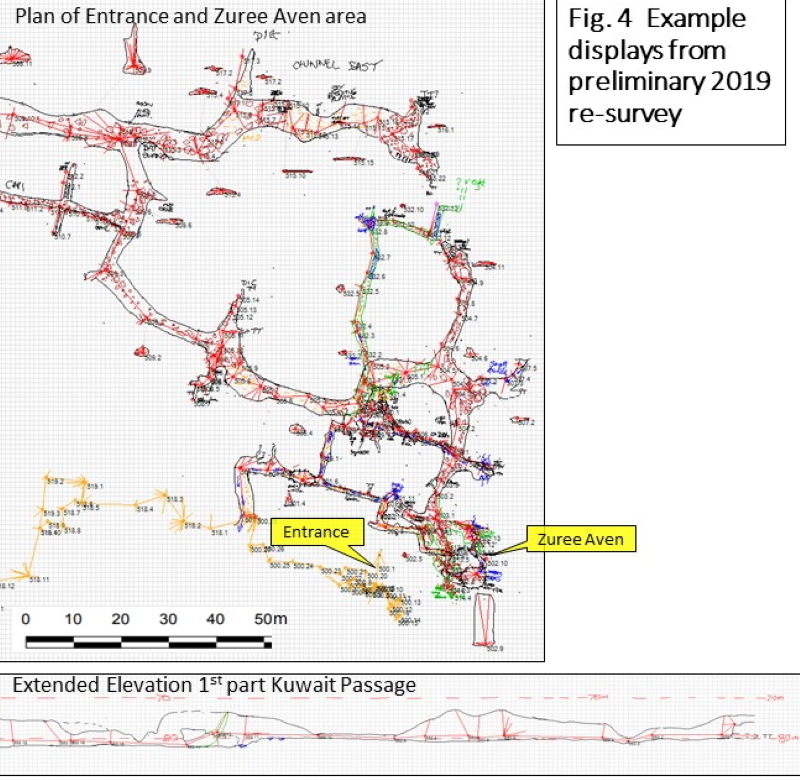
Some examples of ‘raw’ re-survey displays.
The purpose of the current survey work is
to upgrade the 1991-2000 data and add in new data where required. The
workflow so far has comprised a thorough check and clean-up of the 27
year old Compass database using original survey notes and drawings.
Quite a lot of the LRUD data acquired was not previously written to the
Compass database, so this was added in.
All old loop closures were untied so that original and new data
acquisition could be compared ‘like for like’ without closure
distortions. With Paul Taylor’s help nearly all the original survey
sketches, data tables and cave drawings were found and they have been
checked off against the digital Compass data. In general, only minor
acquisition or transcription errors were found. These were corrected and
did not affect the cave plan very much.
No elevation displays were drawn up before and these will be made from
both the original and new survey data. However, it appears that minor
systematic clinometer instrument errors of ~1 degree were present in
quite a lot of the original data recorded. This doesn’t sound much but,
when dealing with such long continuous passages over distances of 1km or
more, 10s of metres height difference do result. It seems that it was
mostly this which led to the anomalous estimate of final (air-filled)
cave depth ~20m lower than the resurgence at the Slaughter Rising about
1.5km WNW of Sump 4. However with the benefit these days of better GPS
and published OS map elevations it can be deduced that another
contributing factor to the disparity was an over-estimate of the
resurgence elevation by ~15m. Use of the modern Compass software has
also allowed a more accurate estimation of magnetic declination to be
applied to the entire previous dataset which spanned years 1991 to 2000
during which the earth's declination changed by ~ 5 degrees here.
New test acquisition was started in late 2018 using modern DistoX laser
techniques and PDA recording/drawing. This, together with consideration
of the evolving scientific objectives, showed that around half of the
cave would benefit from new survey acquisition, particularly along key
through routes and also where passage inclinations are steep, such as in
the Entrance Series and around Zuree Aven. This task was underway by
mid-2019, but workflow was severely interrupted by covid restrictions.
Nevertheless 12 survey trips have been made to date, totalling ~4km and
about ~2 ½ km more are intended.
Minor passage survey additions have been
made which were missing before, yielding an extra ~300m to the surveyed
cave length so far. All the new data recorded has LRUD information plus
plenty of extra splays to help passage drawings both in plan and
elevation views and plenty of passage cross-sections to help with
speleogenesis and water tracing work.
The forward plan on surveying is to complete the new acquisition and
integrate it with the retained vintage data then draw it all up in
Therion software so that in the end a digital survey drawing can be
made, fit for such a fine and interesting cave. This can then form a
reliable 3D framework in which to fit the water tracing, geology and
speleogenesis observations. The intention is make the survey results
‘open access’ available for the caving community as a whole.
Geology
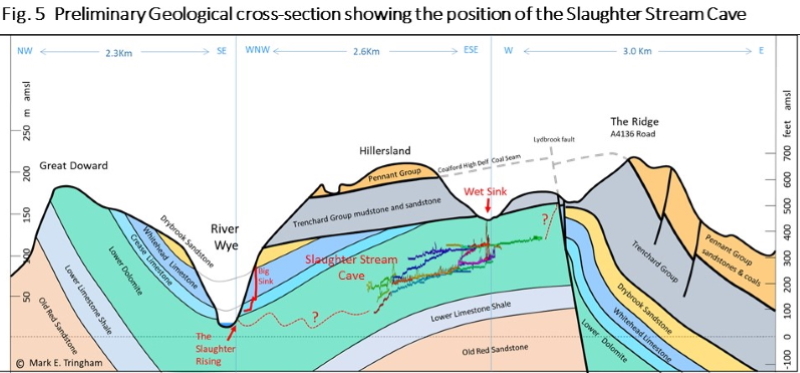
Note: vertical exaggeration x9
The cave appears to be largely formed in
the Lower Dolomite Formation (Fig. 5) and although entirely natural and
not mined it contains interesting iron and manganese (?) deposits,
shelly fossil layers and archaeological remains such as 'Norman' the dog
skeleton and bones and teeth from hippopotamus and mammoth. Disused
coal mines in the Coleford High Delf seam overlie some western parts of
the cave but these are separated from the carbonate sequence by at least
100m of shales and sandstones of the Trenchard Group which almost
certainly form an aquiclude.
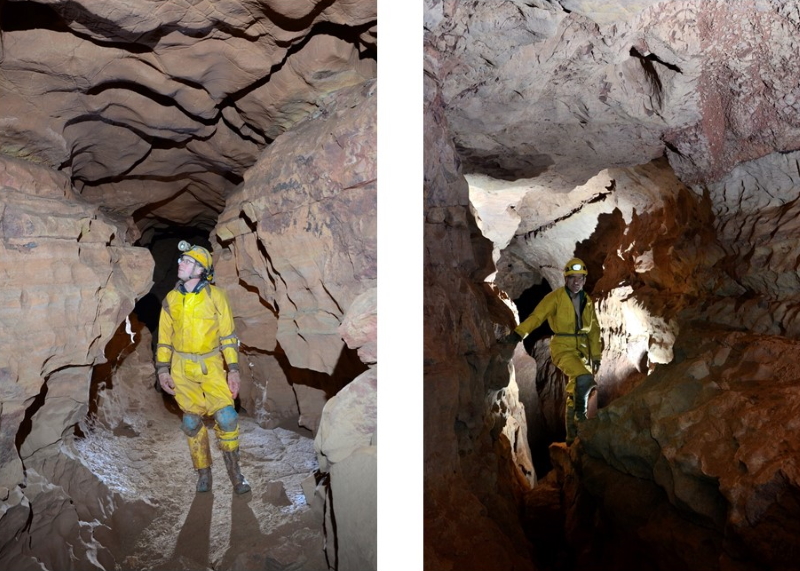
Dog's Grave Passage
One scientific objective is to quantify and
understand the proportion of dolomite versus limestone and find out if
the cave passages are preferentially developed at certain more soluble
stratigraphical horizons within the Lower Dolomite or if the passage
positions are determined instead by former and present water table
depths during down-cutting of the River Wye. Caves formed in dolomite
are much less common than in limestone because of its lesser solubility
and to have a 13km system largely in dolomite is exceptional. However, a
few parts of the cave, for example the lower part of Coal Seam Passage
(a misnomer) and parts of the Remelt Series appear to have formed in
limestone. Hence another objective is to find out if the cave crosses
faults into surrounding limestone formations or if a lateral facies
change to Limestone occurs in the Lower Dolomite Formation. Around ~50
rock samples have been collected from within the cave and are at the
University of Manchester Earth & Environmental Science department
awaiting future mineralogical and petrographic analysis.
Unfortunately delays due to covid have held up this element of the work
for at least a year already, but some results are expected later in
2021.
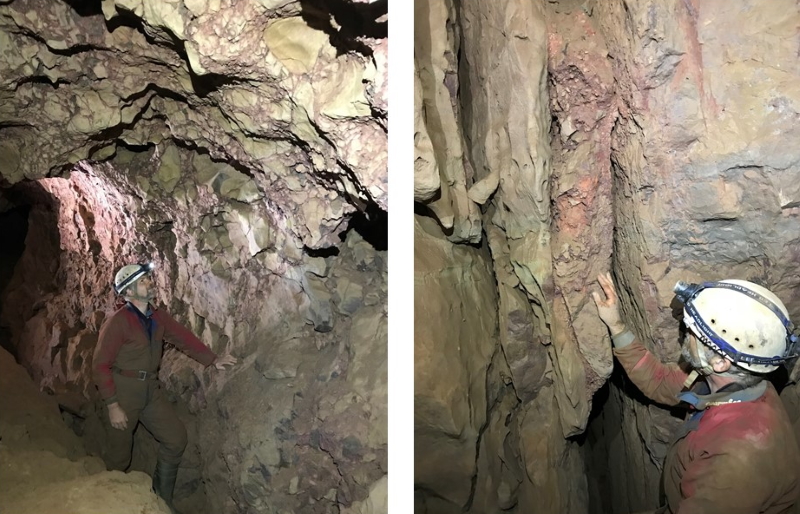
Remelt Series crease limestone(?)( left). Dog's Grave Passage breccia with haematite (right)
Red haematite iron ore veins and
iron-stained layers have been noticed in some parts of the cave and
these offer an amazing opportunity to see and study ‘virgin’ unmined
deposits which elsewhere in FOD have nearly all been mined away and less
useful for study. Also, black mineral deposits have been noticed in
some other parts of the cave which coat the walls and replace fossil
shell layers. Although work on these has not yet started, it seems
likely from their appearance that they are formed of manganese and
biomediated in origin. It is hoped that we can interest academic experts
at the University of Bristol’s Geology Department to help investigate
these.
Speleogenesis
The cave is characterised both by active a
relict stream passages that show evidence for both phreatic and vadose
origin. It is intended that the cave resurvey and scientific
observations on features such as passage profiles, wall scallops,
sediment deposits and preserved ripple marks will permit a synthesis on
the phases and possible timing of cave genesis. It will be interesting
also to determine if any relict parts of the cave might have a hypogenic
origin perhaps related to mineralisation phases, rather than being
epigenic from sinking surface waters, as is occurring at present.
Conclusions
Much interesting work is in progress in the
FOD and in particular the Slaughter Stream Cave with various strands of
work likely to lead to a much-improved knowledge of the cave
morphology, geology and origin. These will likely provide a prime
example for a long cave system formed largely in dolomite, unlike any
other known in the UK. The work in progress requires a strong team
effort with surveying, photography and scientific observations
required. Willing helpers or specialist research workers please
make your interest and availability known to the author ready for
resumption of work with day trips and a few overnight underground
bivouacs planned later in 2021.
References
Lowe D.J. (1989) Limestones and caves of
the Forest of Dean. pp. 106–116. In Ford, T D (Ed.), Limestones and
Caves of Wales [Cambridge University Press].
Solari R.A. (1974) Hydrology of the Slaughter Rising. Cave Projects Group Newsletter, No.5, 54–6
Taylor P.W. (2020) Forest of Dean Dye Tracing Project (Slaughter and
Ban-y-gor catchment areas) history and interim results. Cave and Karst
Science, Vol.47, No.1, (2020) pp. 19–22.
Mark Tringham
|
|
A QUESTION FROM COUNTY CLARE
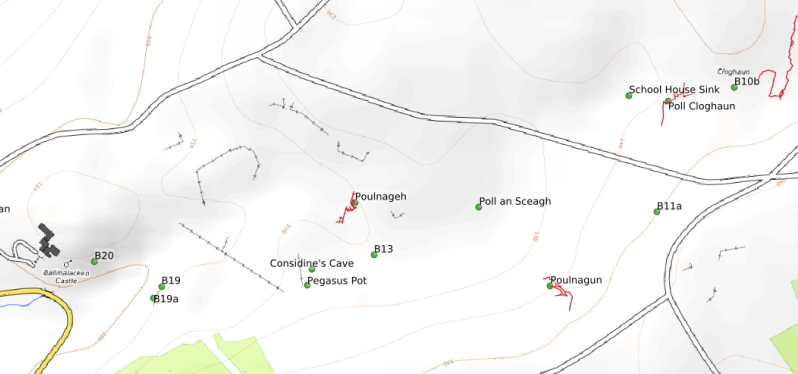
Graham Mullan poses a question for our older members and anyone
with an interest in the history of exploration in the Burren, so read
on, and cast you mind back to days of old, when cavers were bold...
Following the continuing survey work in the Coolagh River Cave by Ash
Gregg and his merry band, I have spent quite a lot of time staring at
the sites in the Lower Coolagh Valley, from the bottom of the cave down
to Ballynalackan.
It is strikingly obvious, both from the maps and the written accounts
that the site which should be key to unlocking this area is School House
Sink (B10d). What seems strange is that I can find no account of us –
or indeed anyone else – attempting to open the sink up. We have dug at
all sorts of obscure places, here and in other parts of the Burren, but
seemingly not at this most obvious and promising of sites.
So, my question is this. Can anyone remember any attempts to dig here?
Did they fail? Were they refused permission? Or has nobody actually had a
go?
I know someone locally who has been quietly negotiating with the current
landowner to dig here, when circumstances permit, so the question of
its potential might well be answered in the near future. Hopefully,
it’ll prove as promising as it looks. If you know anything about the site, please get in contact.
Graham Mullan
|
|
I READ TO THE END, HONESTLY!!

Image from freepiks.com
The winner of last month's competition was
Andy Farrant, busy procrastinating at work, waiting for his next
appearance in a national newsletter! And it's not true that he won just
because he says nice things about us, but it does help.
Keep those emails coming! It's a real bonus for your editorial team,
slaving over a hot computer, to know there's a readership out there!
Plus it gives us a steady stream of victims for articles, but don't let
that put you off!
- Awesome read as ever! (Andy Farrant)
- Good newsletter! (Zac Woodford)
- Again slow ... but fascinated by the Fishmonger’s story. Start
the joke series with knowing which plaice the cave is at. (Chris Howes)
- OK, got there. The End (Dick Willis) (Eds: In the interests of
accuracy, this was actually a response to the previous issue, so Dick
wins a prize for being the latest entrant to that one!)
- Just for you (Graham Mullan)
- I did read to the
end, albeit quite slowly. I’ve already won a prize, so let’s not get
greedy (and it resulted in me having to write an article, so I’m slower
off the mark these days). (Ian Wheeler)
- Have not got to the
end yet (typically takes me a month or more) (Steve
'Professor/Dr/Mr) Hobbs) (Steve also kindly pointed out the incorrect
date for the AGM in the last newsletter, so at least someone was awake!)
- Trust me, I r a gernalist and I read to the end. Shame it was
probably a week later than anyone else, but you can blame shovelling
work shit at high speed. Spiffing work, everyone - another good
newsletter. (Sharon and the blessed FT Bear)
- Got there eventually! Am I a newsletter behind yet? (Cat (see, i do still exist, just busy :) Henry)
Now,
who read to the end this time? Late entries accepted! For those new to
the game, there will be a splendid prize for the first person to read to
the end and tell us that you did!
THE END
|
|
|
|